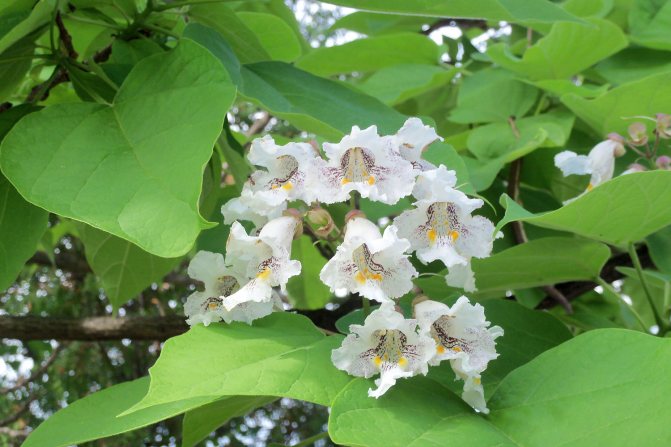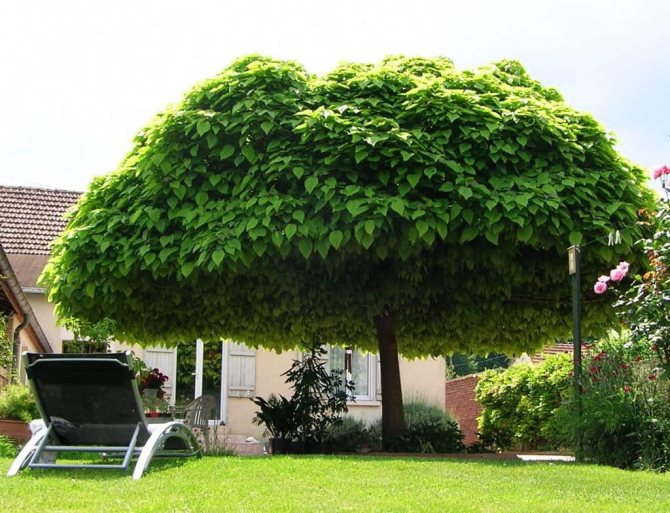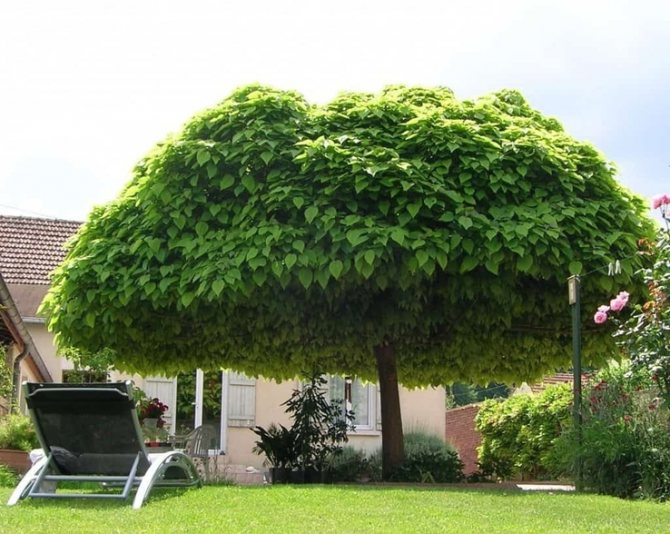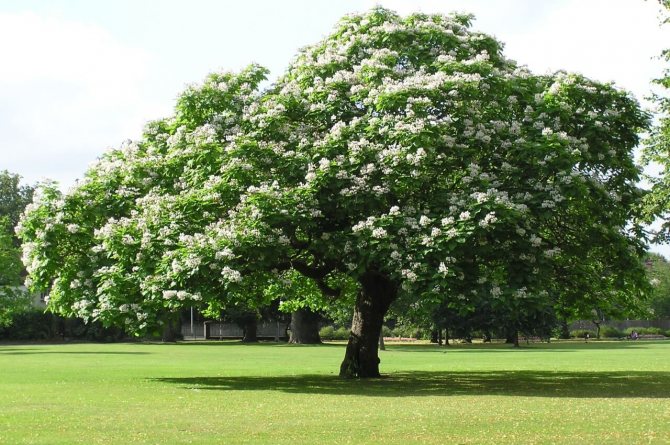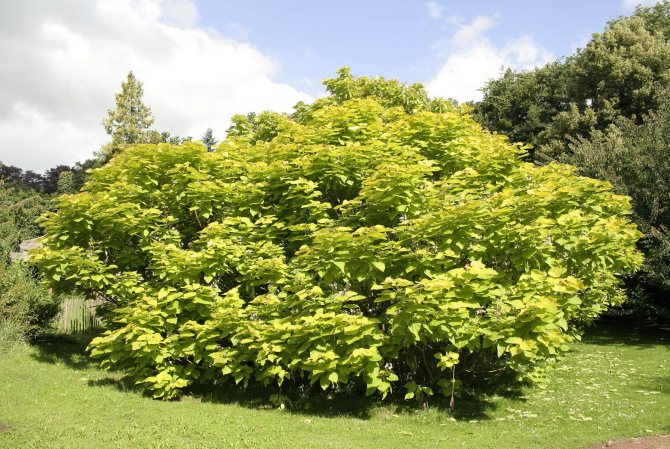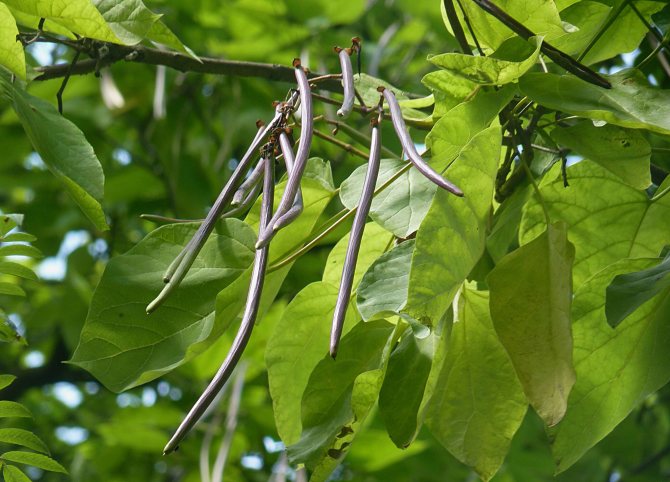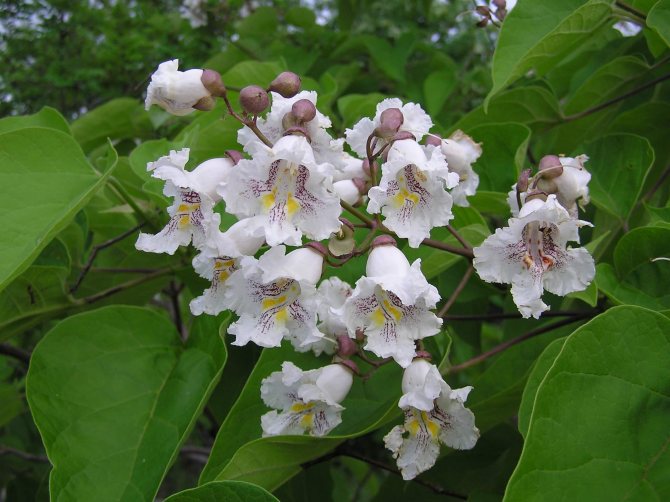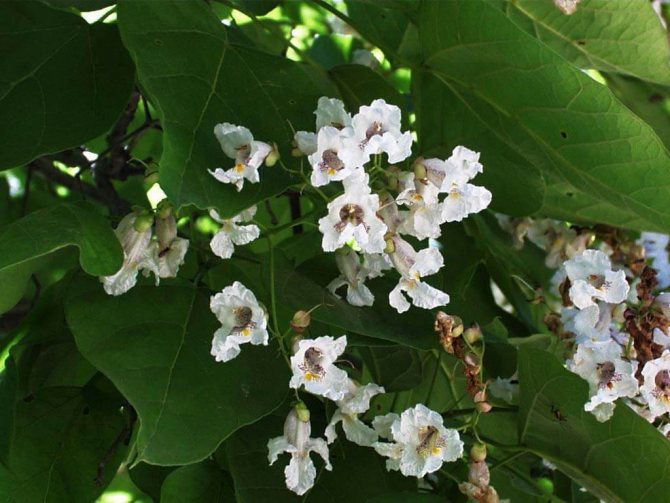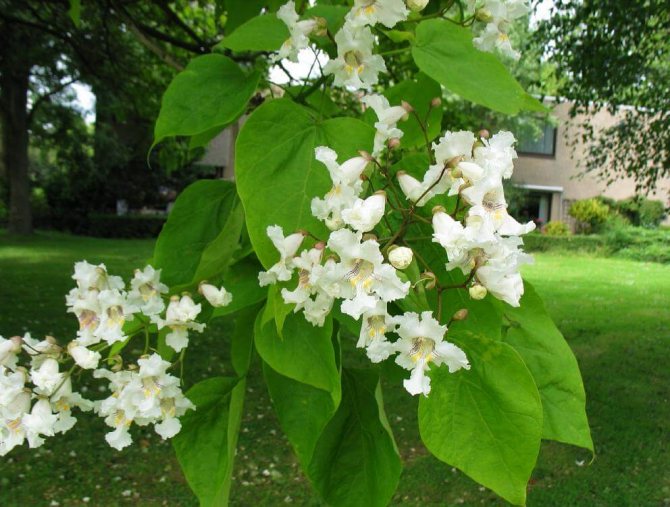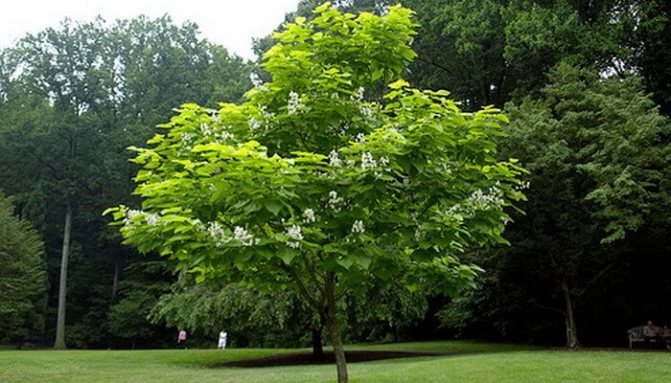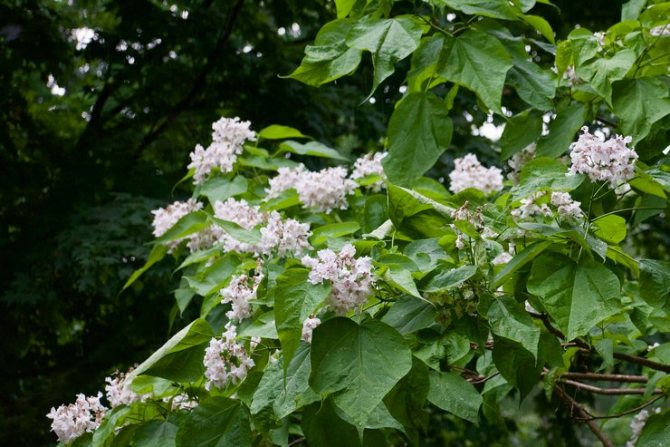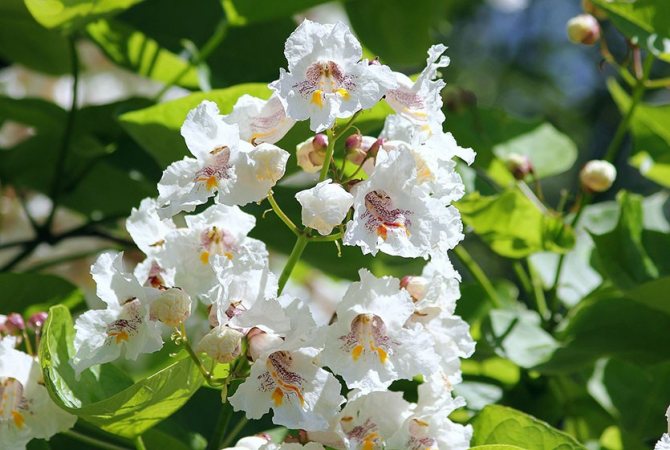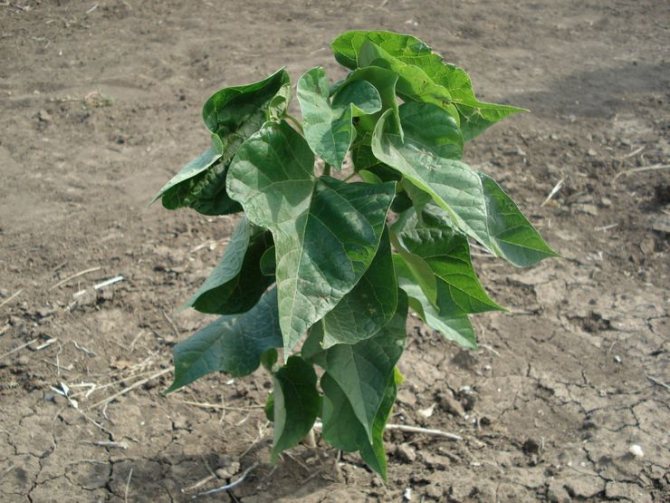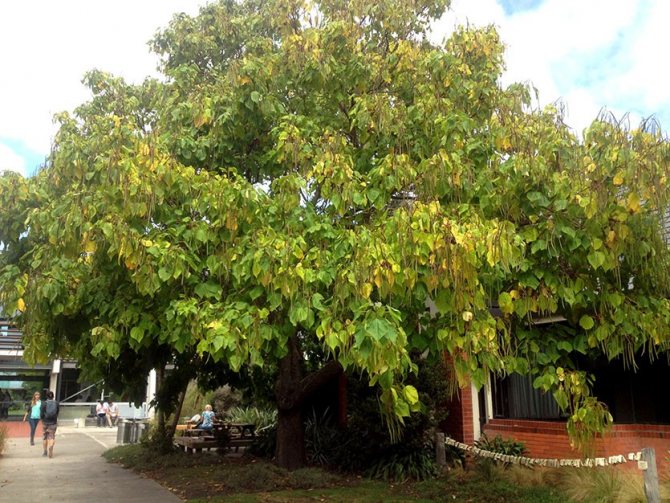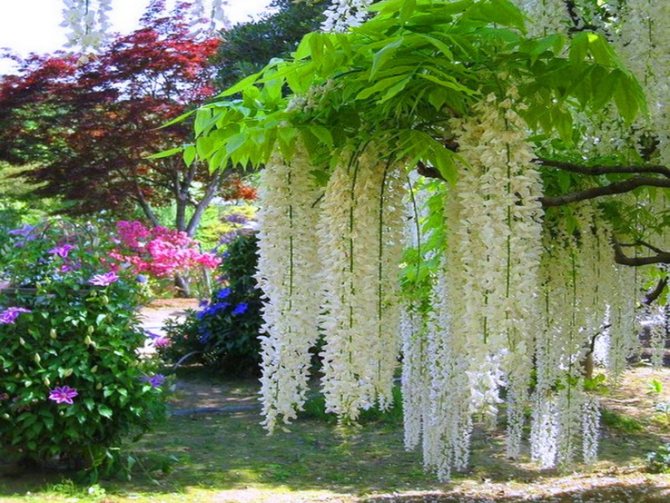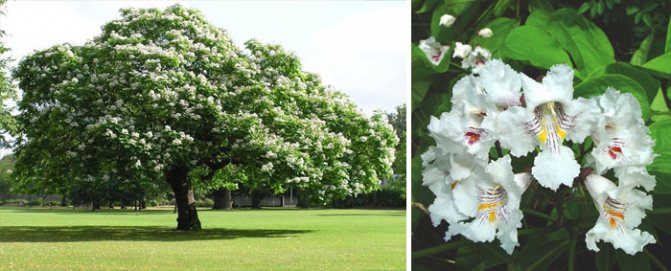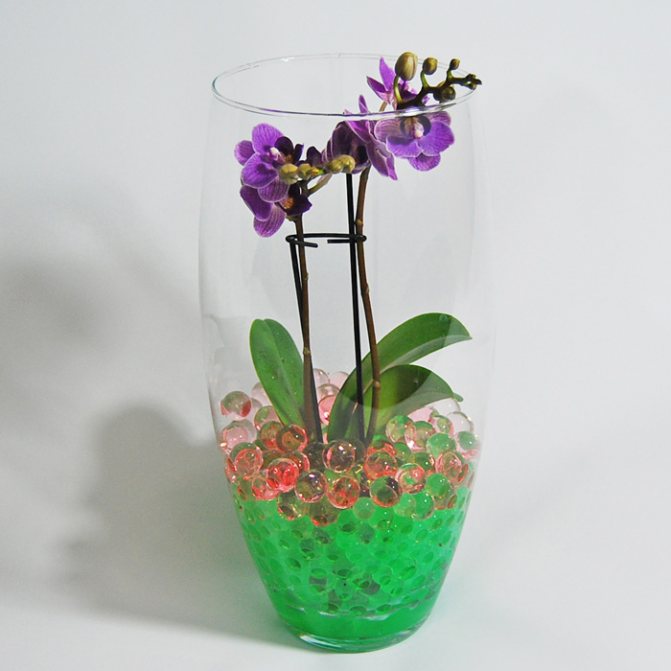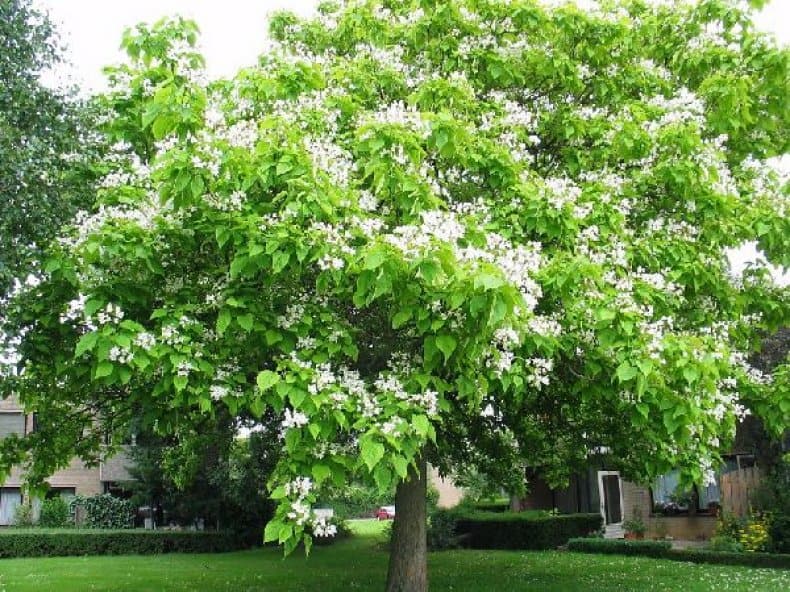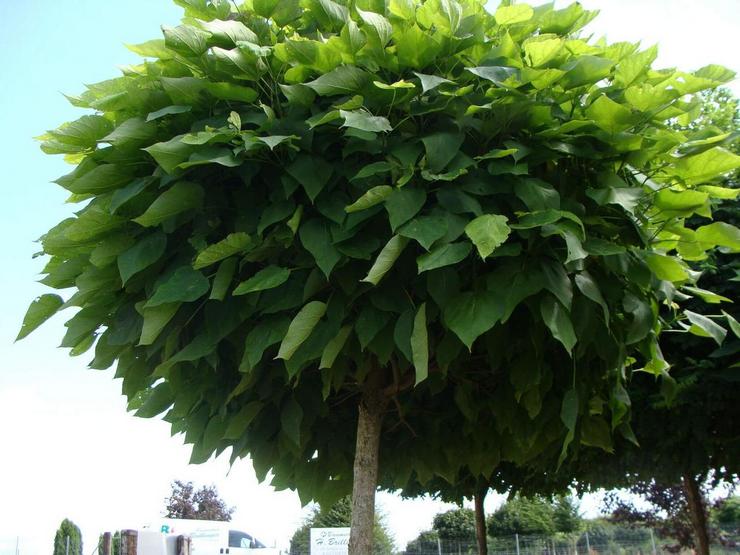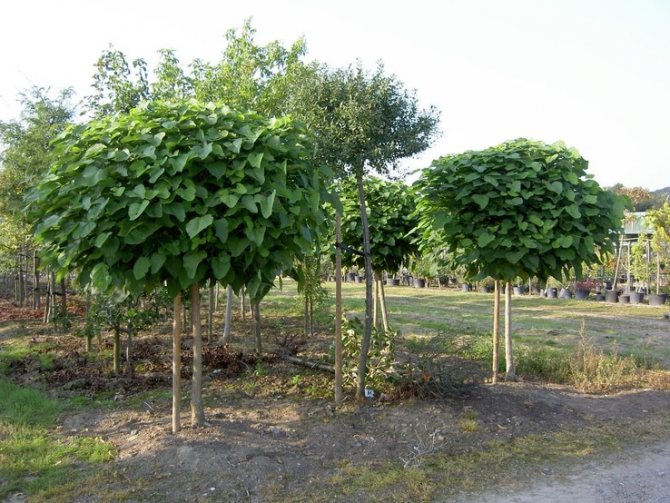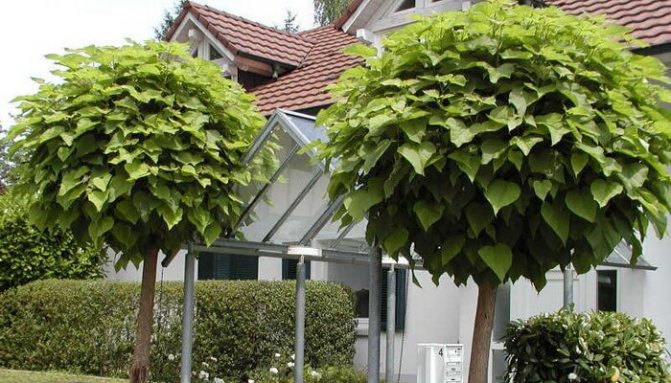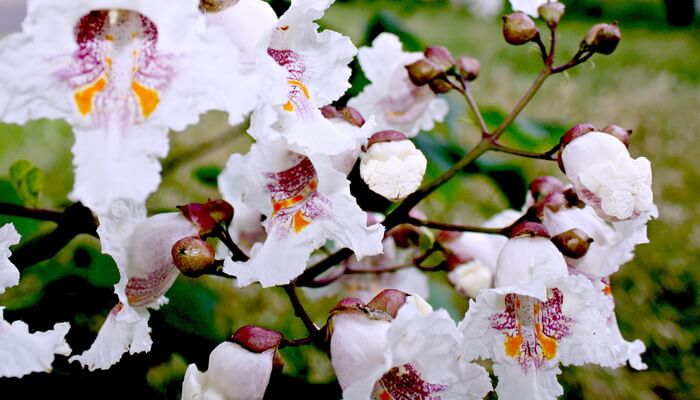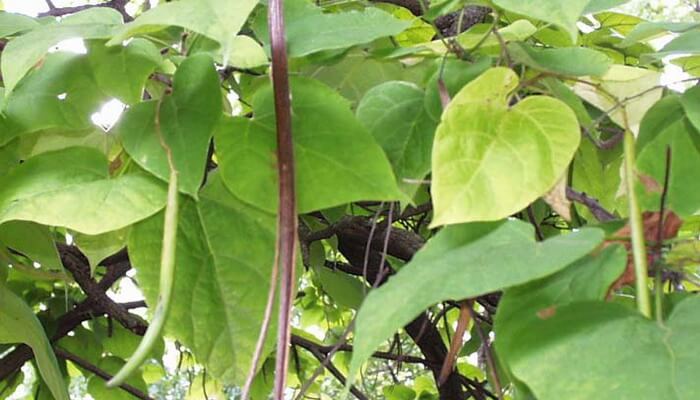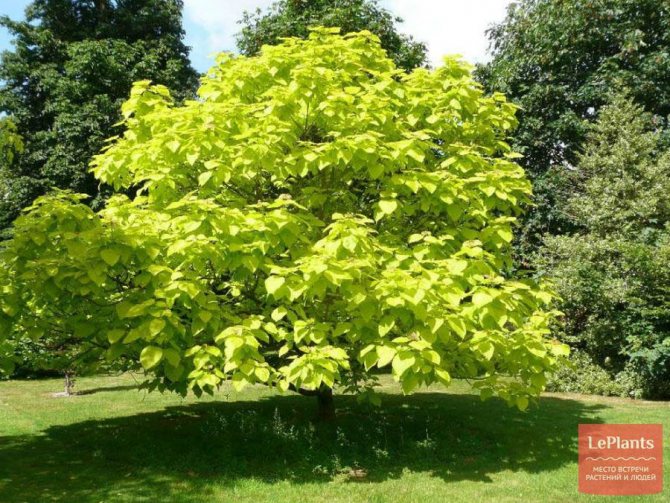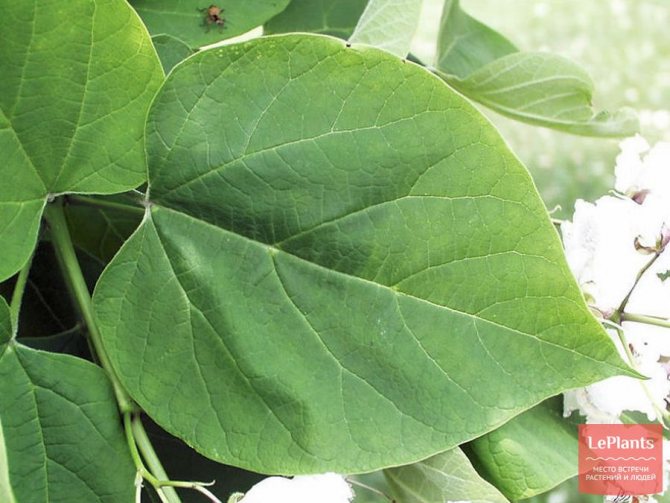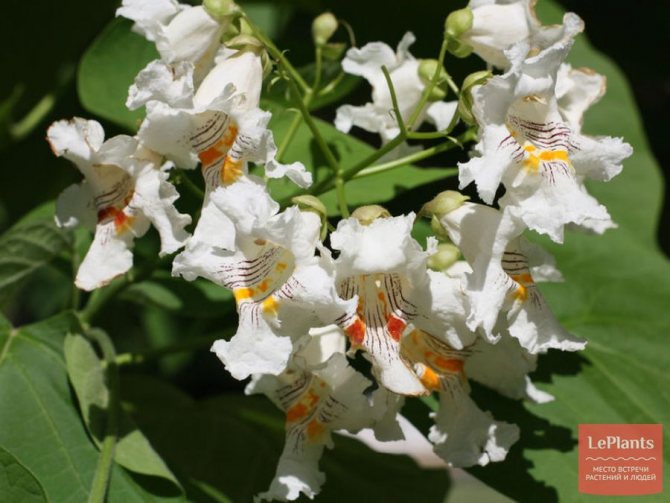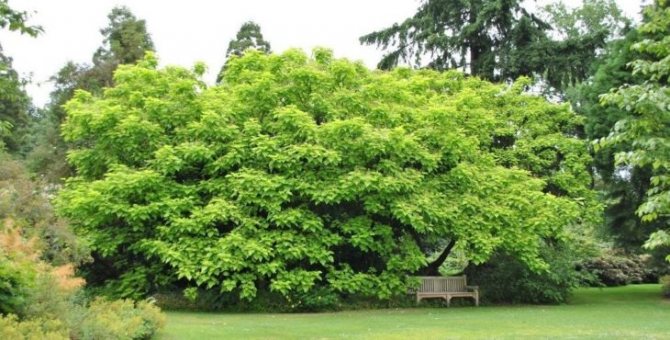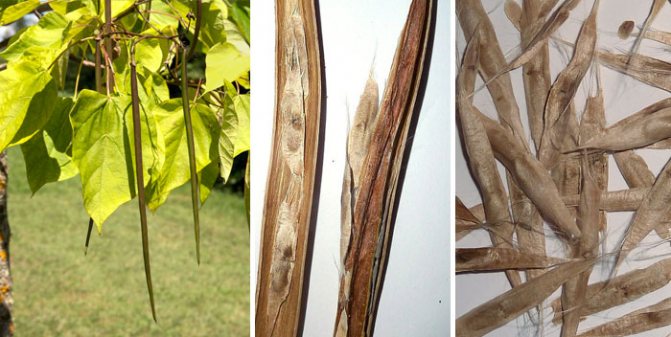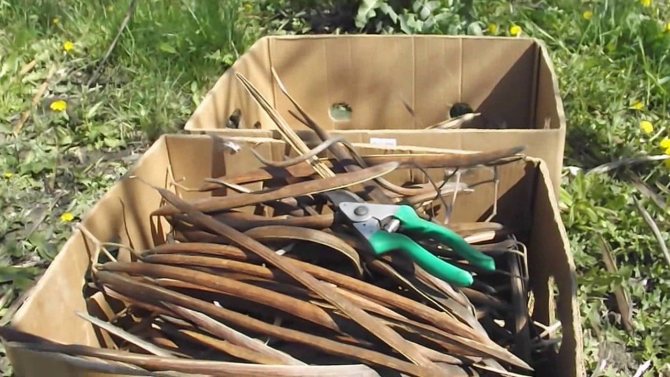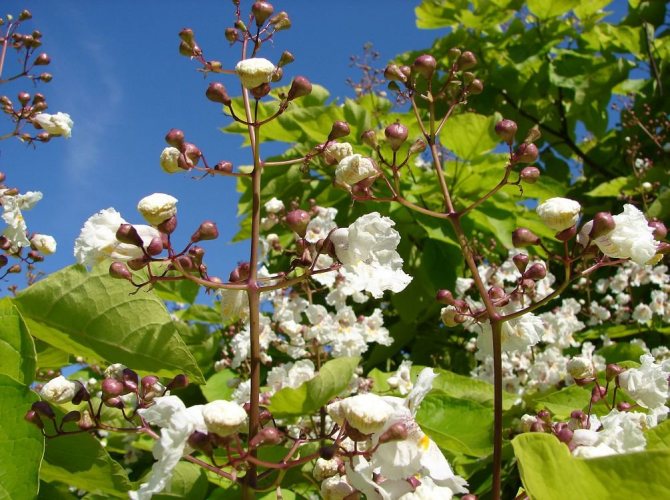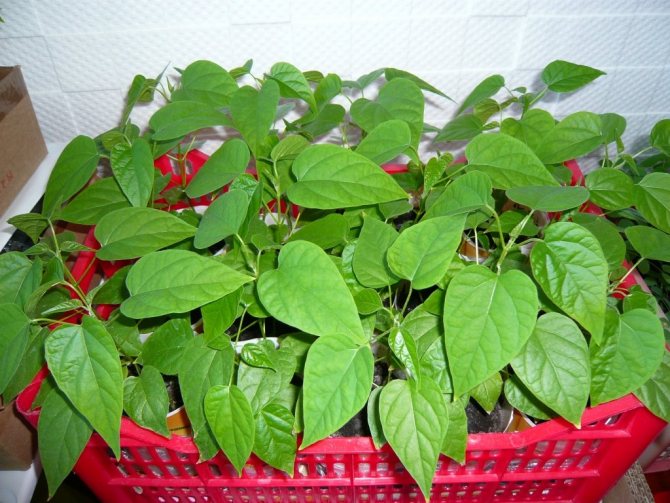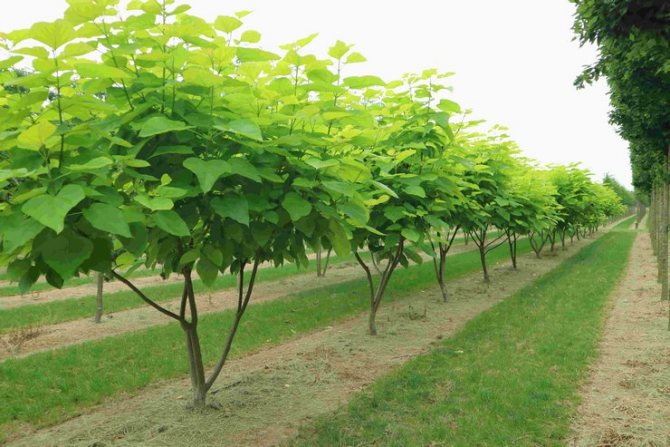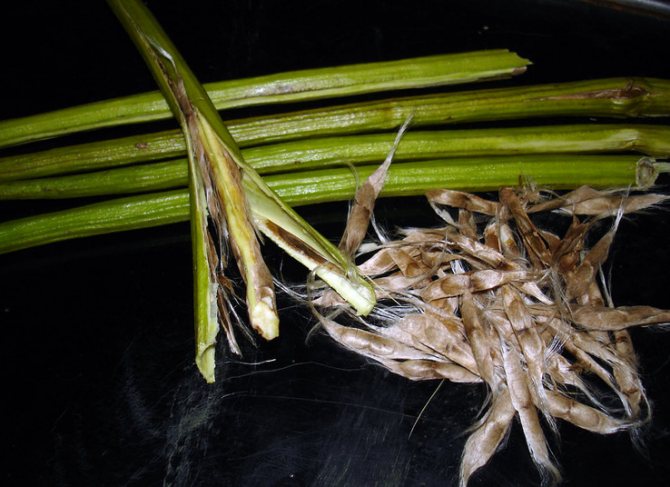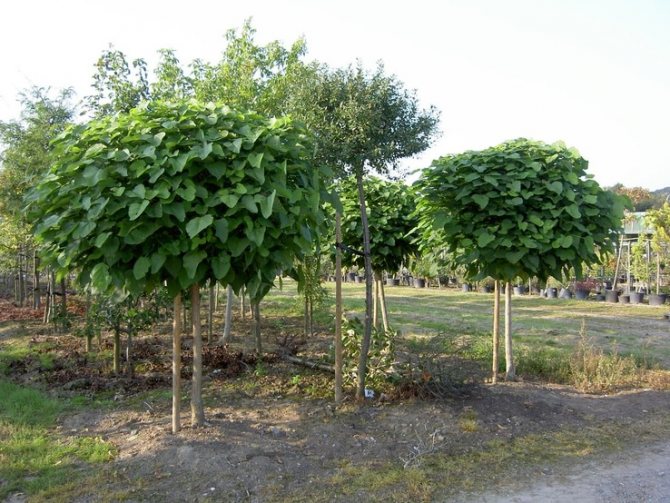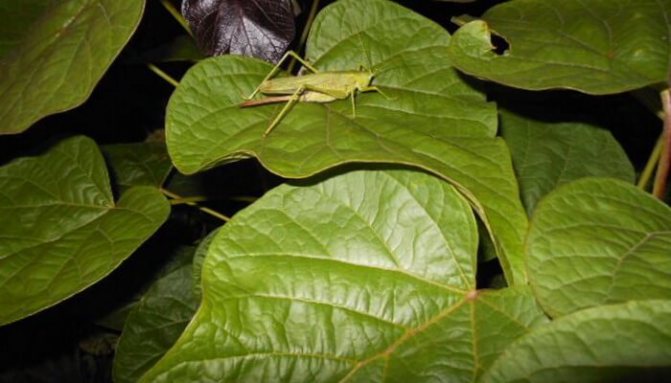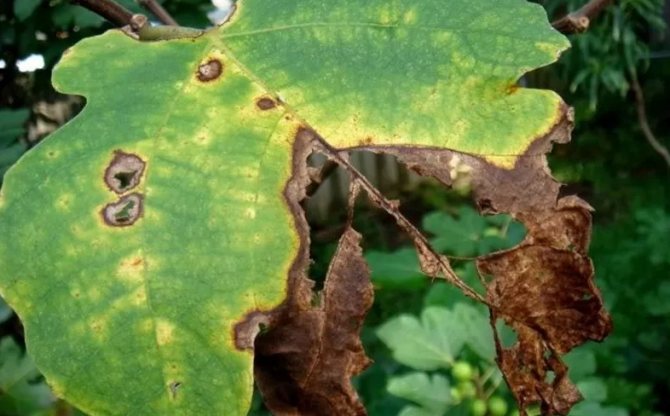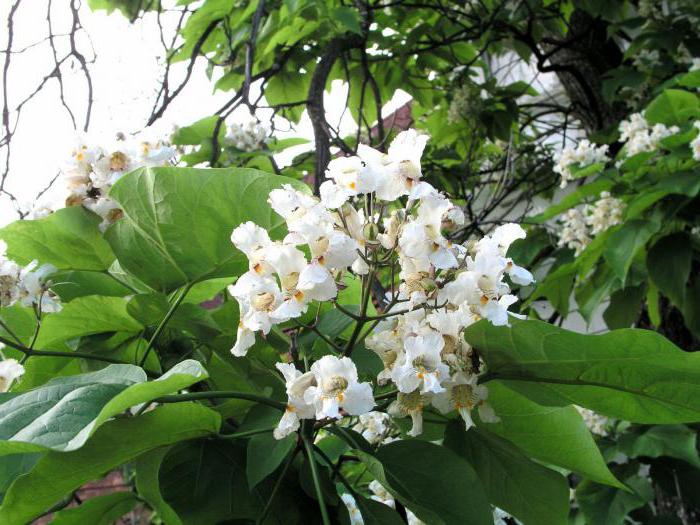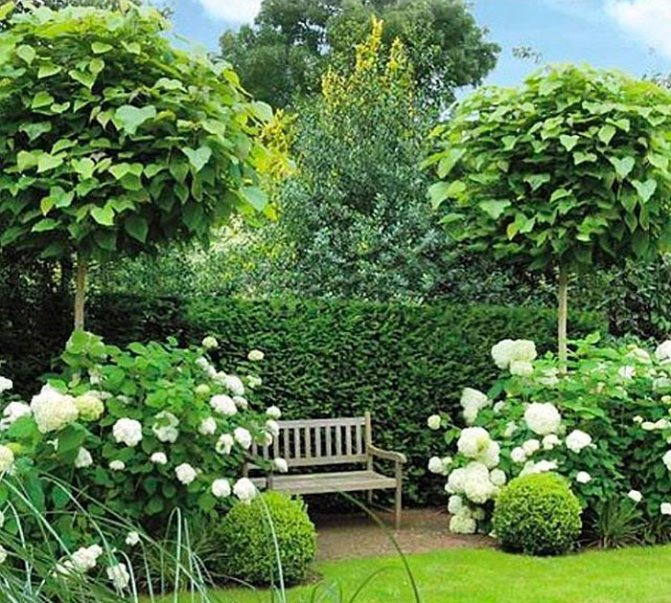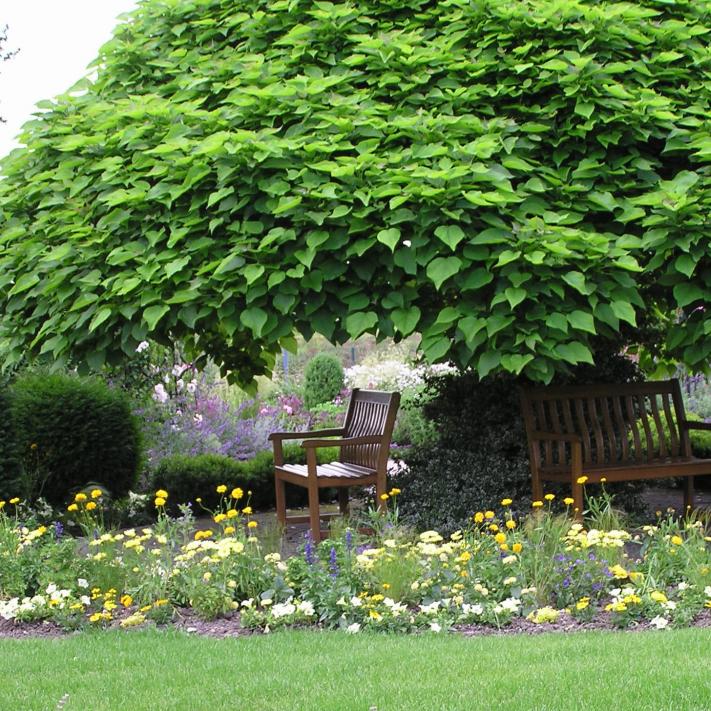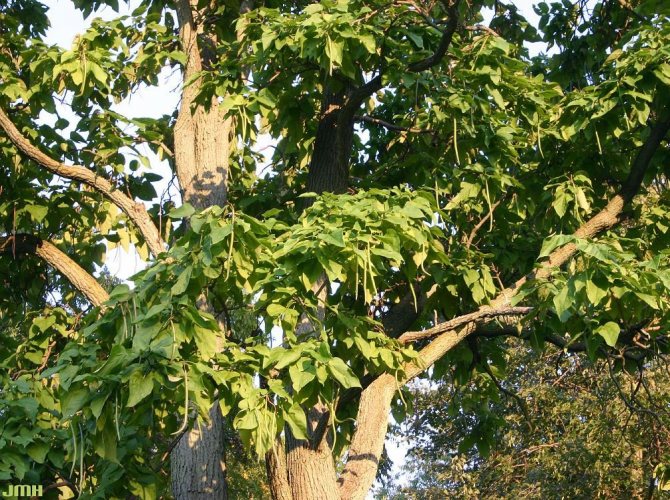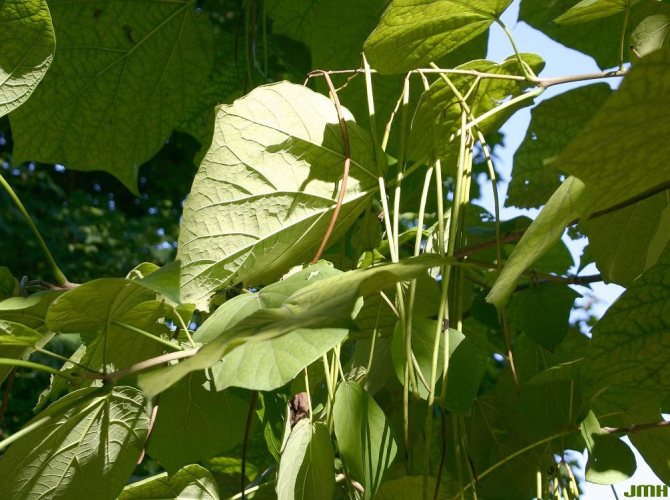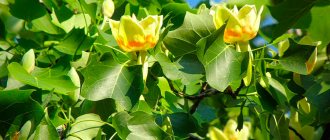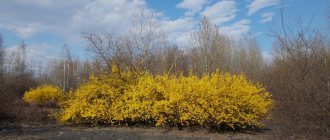A photo and description of the catalpa tree, planting and caring for which does not differ much from the usual garden plants, show a surprisingly decorative culture. Its appearance is misleading to many. It might seem that a bright, luxurious tree requires special growing conditions or careful shaping. In fact, planting and growing catalpa is not difficult, and its rapid growth, disease resistance and frost resistance fully justify the work of gardeners.
General information
They called it "katoba", however, a little later it was renamed catalpa by the Italian scientist and botanist Skopoli. It was he who first studied and described catalpa, revealing this exotic plant to the world.
The genus Bignonium combines from 10 to 38 species of catalp. Some of them are cultivated in the southern zone of Russia, Belarus and Ukraine, while the rest can only be seen in the wild.
Catalpa is an unpretentious and rather easy-to-care plant, so if you want to decorate your garden area, giving it beauty and originality, then it is exactly what you need.
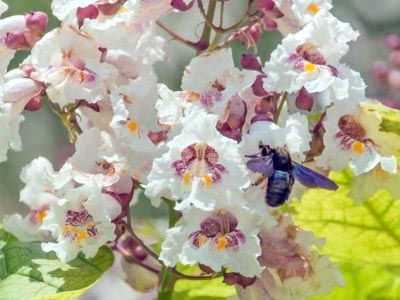
Photo gallery
Catalpa species and varieties
Catalpa bignoniform - in the wild, the tree can be found in North America. It grows on the banks of rivers. The plant reaches a height of 20 meters. Catalpa has a spreading, rounded crown. The bark of the catalpa is thinly lamellar with a light brown color. The leaves are large, light green, resembling lilacs in appearance.
The inflorescences of the plant are pyramidal. They reach 20 centimeters wide and 30 centimeters long. The inflorescences consist of small fragrant flowers of white color with red-brown specks. The flowering period is 20 days, after which long, narrow pods with small seeds begin to form.
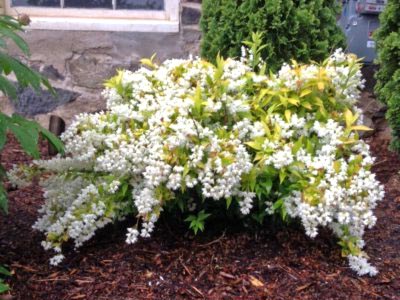

Catalpa is beautiful - the homeland of this variety of catalpa is North America. An adult tree reaches a height of 30 meters and has a wide pyramidal crown with large light green leaves and a thin gray bark.
The inflorescences of the plant are panicle-shaped and consist of small, pleasantly smelling cream-colored flowers with purple specks. Catalpa fruits are small capsules that crack when ripe and drop the seeds to the ground.
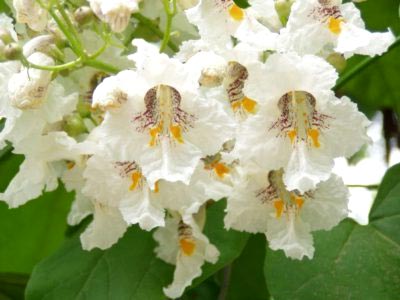

Catalpa is magnificent
The crown of the tree has a pyramidal shape. The trunk is covered with a thin gray bark. Leaves are large, dark green. The inflorescences are creamy with yellow stripes and dark specks.
The scent of flowers vaguely resembles apple. Catalpa blooms for only a month. Grows in fertile soil and loves importance. This type of plant is distinguished by frost resistance and good resistance to diseases and pests.
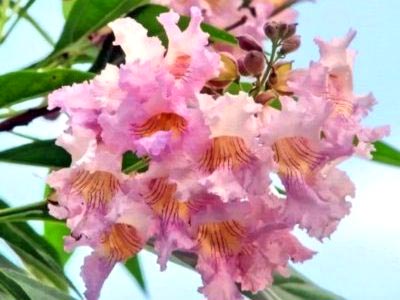

Catalpa nana - is a small, slowly growing tree with a spherical crown with a dense light green leaf. The height of the catalpa reaches from 4 to 6 meters.
Flowering time from June to July. The flowers are collected in large inflorescences with a pleasant aroma and a pale beige tint with yellow stripes and brown specks. Catalpa fruits are narrow, long, pod-like.
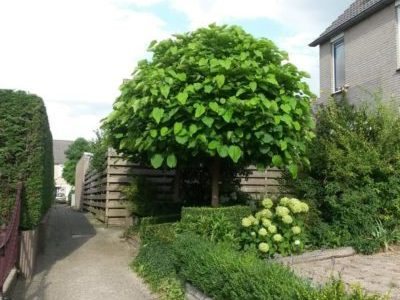

Spherical catalpa - this variety was bred by crossing ovoid and common catalpa.The tree reaches a height of 16 meters and has a luxurious rounded crown with a light green leaf cover. Catalpa inflorescences are loose and large, consisting of small white flowers with purple specks on the outside of the petals.
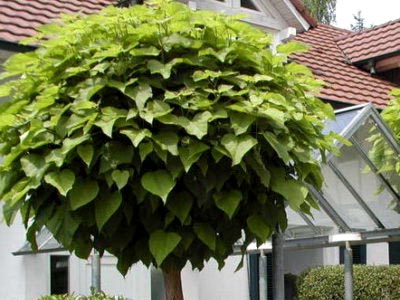

Catalpa ovoid
The plant is native to Central China. An adult tree reaches a height of 10 meters, but when grown in a garden plot, the catalpa does not grow more than 4 meters.
She is the owner of large, pleasantly smelling flowers of a white shade with a purple throat, collected in large brushes. The fruits of the plant resemble thin and long pods. Catalpa needs a lot of light and nutritious soil to grow and develop.
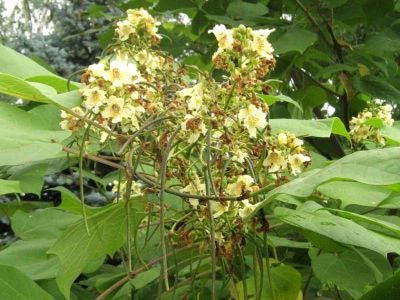

Catalpa blushing purpurea - an adult tree reaches a height of 10 meters. It has a dense pyramidal crown with large leaves, very unusual in shade. When the leaf plates only bloom, they have a purple hue, but after a month, they change their color to light green.
The plant blooms with small flowers, similar to white bells with purple specks, collected in large and long brushes. The flowering time of the catalpa falls in the middle of summer and lasts only a month.
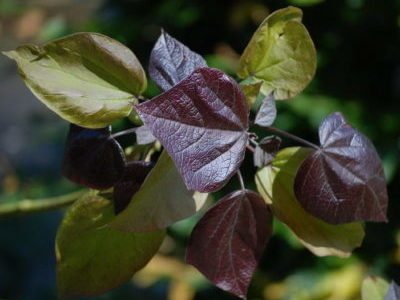

Common catalpa - the tree has straight stems with a dense leafy cover of a light green hue. The height of the tree reaches 8 meters. Catalpa blooms throughout the month in large clusters with small white inflorescences with a purple throat. The seeds are thin and long pods that ripen in mid-fall.
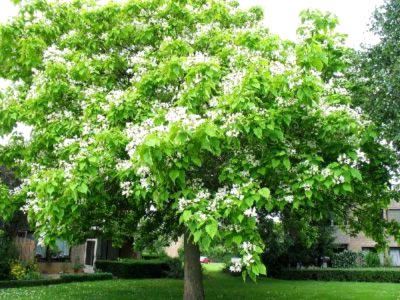

Catalpa bunge - the homeland of the plant is North China. The variety is named in honor of the botanist from Germany Alexander Bunge, who is the discoverer of this variety. The tree has a pyramidal crown with luxurious large leaves of a dark green hue. The inflorescences of the catalpa are small. They consist of 3-12 white small flowers with purple specks, after flowering of which pod-shaped fruits appear.
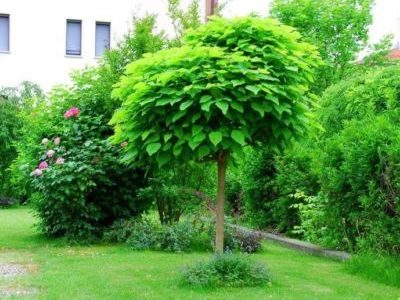

Catalpa graceful
It is a tree with a height of 8 to 10 meters. In the wild, its height can reach 20 meters. The crown of the catalpa is dense, having a pyramidal shape. The leaves are large, dark green. Small flowers are collected in large, racemose, pleasantly smelling white inflorescences with purple specks. The flowering time of the plant is in the middle of summer.
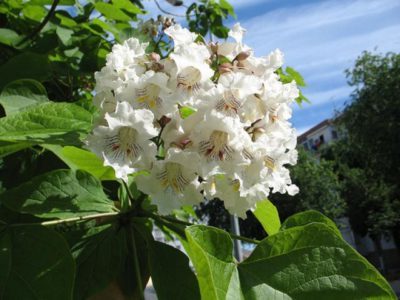

Catalpa aurea - This type of catalpa reaches a height of 8 meters and has a dense, pyramidal crown with large light green leaves. The tree blooms in June. Flowers are small, fragrant, collected in large white inflorescences with brown specks.
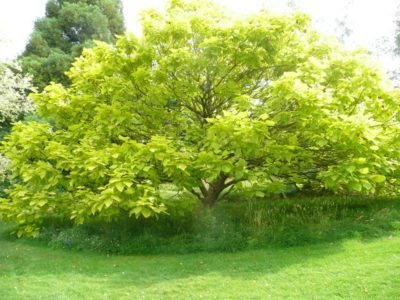

Catalpa hybrid - the tree grows up to 20 meters and has a round crown with spreading branches. The leaves are large, light green in color with slight pubescence. The plant blooms in mid-summer with beige-white flowers with a purple throat, collected in loose large brushes. After flowering, long, pod-shaped fruits are formed.
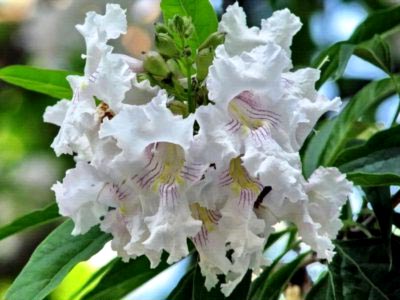

Catalpa fargesa - in the wild, the plant is found in the forests of Western China. The height of the tree reaches 20 meters. It has a wide, dense, spherical crown with a dense dark green leaf cover.
Catalpa blooms in June. Purple or pink flowers with an orange throat are collected in large, friable, pleasantly smelling clusters. After flowering, long and thin fruits are formed in the form of pods.
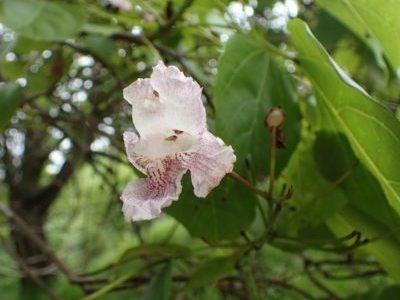

What is Catalpa
The plant, which originates from North America, was considered a sacred tree by the indigenous Mayan tribes. The fragrant flowers of the plant were dedicated to the born girls, and the long fruits resembled the hairstyles of boys - numerous braids.Growing up, male offspring became warriors, and the shape of the leaves symbolized the hearts of men who died in battle.
The trees and bushes of Catalpa are considered by botanists to be relict plants that have hardly been touched by evolution. The beautiful plants grown today had the same look before the ice age. On the American continent, trees grew along rivers, on wet banks. Species originating from China later settled in Japan, and American catalps were introduced to Europe.
Today, flowering catalps can be found in many countries and not necessarily with tropical climates. They grow in the south and in central Russia, in China, East India, and Japan. Some types of thermophilic trees have proven to be able to withstand quite severe winters and are quite suitable for growing in temperate climates.
All types of catalpa in places of their historical growth were used by the population for medical purposes. The Indians treated coughs, malaria, and wounds with the bark and roots of the tree. Chinese medicine uses catalpa in the treatment of tumors, abscesses, diseases of the stomach and respiratory system. The ability of all parts of the plant is known to drastically lower blood pressure, up to fainting. The roots of the tree are extremely poisonous, so the tree has not found medical use in Europe.
Catalpa landing and care in the suburbs
Planting a catalpa and caring for it is not much different from any other decorative tree. A catalpa seedling can be purchased both in the nursery and grown from seeds on your own. It is necessary to plant a young tree in a garden plot in the spring, before the period of sap flow begins, or in the fall, when the trees will drop their foliage.
To plant a catalpa, it is necessary to find a site with good illumination, which will be closed from winds and drafts. This is necessary because the tree has an extremely fragile leaf cover, which is easily injured by gusts of wind and strong drafts.
It will also be a plus if the groundwater on the site is as deep as possible underground. Catalpa loves space very much, therefore, a distance of at least 5 meters must be maintained between a young plant and other trees.
Planting catalpa in spring
The planting hole should be 100 centimeters deep and 70 centimeters wide. At the bottom of the pit, drainage should be laid in the form of crushed stone or broken brick. The drainage layer should be about 15 centimeters thick.
When the drainage is laid, soil is poured onto it, a little more than half of the hole in volume. Then a tree is placed in the substrate, having previously straightened the roots. The remaining void is filled with soil and slightly compacted.
After planting is complete, the tree is watered abundantly. It is necessary to ensure that after absorbing moisture, the root collar descends to the level of the soil surface. Also, the trunk circle should be mulched with peat or straw.
Kampsis is also a member of the Bignonium family. It is grown when planting and nursing in the open field without much hassle, if you follow the rules of agricultural technology. You can find all the necessary recommendations for growing and caring for this vine in this article.
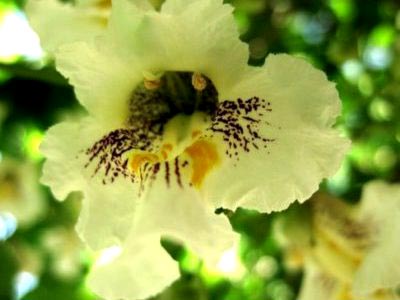

Catalpa tree description
Catalpa (from Latin - Catalpa) is a small genus in the botanical family Bignonievyh. There are no more than 25 varieties in the species range, only 4 of which are grown in Russia. The genus includes both trees and bush forms of catalps. There are noticeable differences between the species in the shade of the leaves, their shape, the color of the buds, deciduousness, and other characteristics, but the appearance of the plant remains very characteristic, easily recognizable in any part of the world.
What does a catalpa look like?
The tree in cultivated plantings reaches 5-6 m, while at home it can exceed 20 m. The trunk is powerful, in some species it is erect, columnar, covered with a grayish-brown scaly bark.The branches form a dense hip or spherical crown. Photos of a catalpa tree often represent a standard form with a smooth, straight trunk. In free formation, the plant can grow a powerful trunk of more than 1 m at the base and a spreading irregular crown.
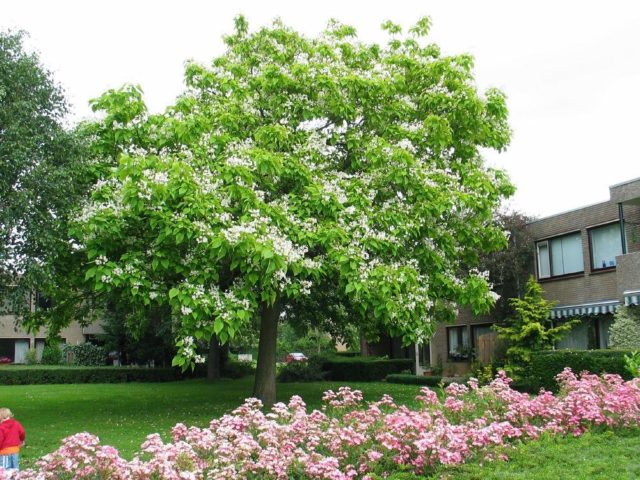

Catalpa leaves are large (up to 30 cm), rounded, often heart-shaped, oppositely attached with long petioles on the branches, in some species they can be collected in whorls. They appear on trees late - by the end of May. Up to this point, the bare plant may appear dead. Leaves fall off in the fall immediately after cooling to 0 ° C, almost without changing color.
By autumn, long, thin fruits, reaching 40 cm, ripen on the trees. Multiple hanging pods give the catalpa a very unusual, decorative look and do not crumble until spring. For the peculiarities of its appearance, the plant received popular nicknames. In different parts of the world it is called the "macaroni tree" for the abundance of long pods, "elephant ears" for the shape of the leaves.
How fast catalpa grows
From the first months of life, the plant is characterized by rapid growth. The hatched seeds turn into small trees in a few months. Under favorable conditions, the annual growth of an adult plant exceeds 35 cm, in some species (for example, the magnificent Catalpa) - 100 cm.
Attention! The vigor of growth inherited by the tree from its tropical ancestors helps to compensate for the lack of winter hardiness of the catalpa in some regions. Frozen parts of the plant are restored in one season.
How catalpa blooms
The most decorative culture, starting in June, when spectacular buds bloom on the branches. Catalpa flowers are able to surprise the most experienced gardeners. They resemble small orchids gathered in loose "chestnut" candles. The petals, depending on the variety, are snow-white to purple in color and up to 7 cm in diameter. Most often, there are soft creamy petals with yellowish stripes and contrasting specks in the center.
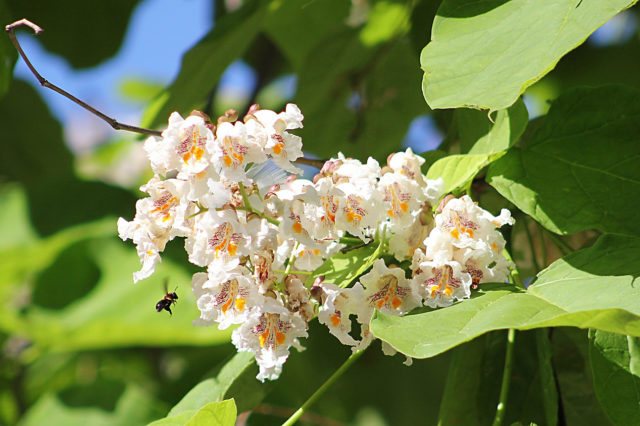

The profuse bloom is accompanied by a sweet, persistent scent that attracts bees and lasts up to 30 days. The pyramidal, erect inflorescences gradually develop into hanging pods. Ripening, long fruit pods are filled with many flying seeds.
Frost resistance of catalpa
The culture loves the sun and belongs to the thermophilic species. With sufficient illumination, a long warm period, the shoots and bark of the catalpa have time to ripen before the cold weather, which allows the tree to winter well. The ability of a thermophilic plant to tolerate frosts above 30 ° C was found.
Important! Some gardeners note that even young shoots do not freeze out at -35 ° C. This is not due to the type of plant, but due to the abundance of sun in the region in summer and a long warm period. In a short, cloudy season, the catalpa does not have time to prepare for winter and can freeze out to the level of snow cover.
The frost resistance of a tree does not directly depend on its species. It has been experimentally established that specimens grown from seed material or cuttings of local plants are fully adapted to climate conditions. Saplings brought from warmer regions take a long time after planting and are prone to freezing.
For the central and black earth regions, the following forms of catalpa are recommended:
- Aurea;
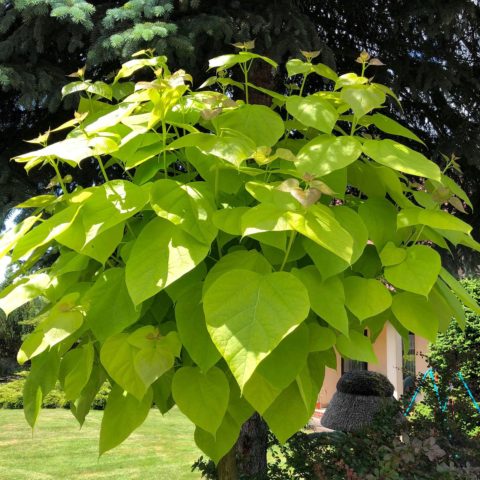

- Pict;
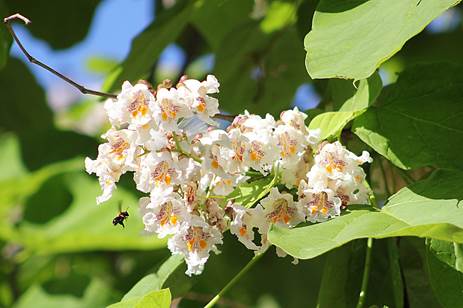

- Nana;
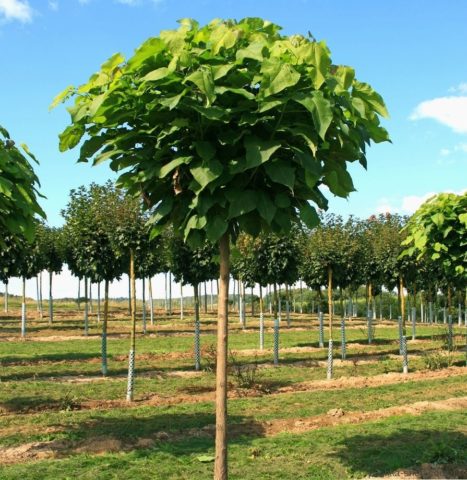

- Captivity.
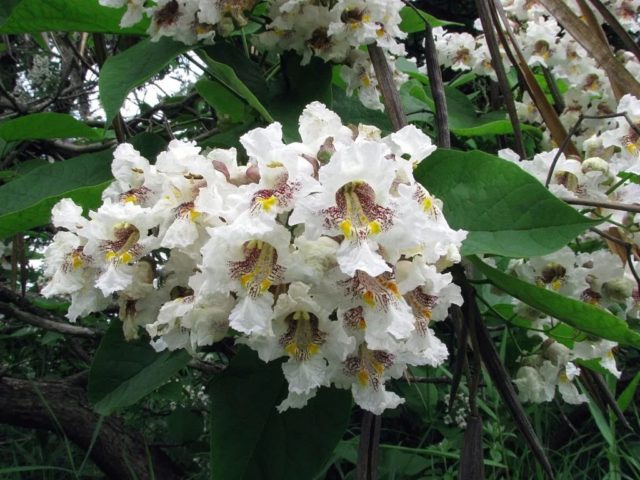

Best suited to the conditions of the middle lane, the catalpa is magnificent. Its trees even tolerate the climate of the northwestern region with a short solar season well. Of the species for cultivation in temperate climates, the types of catalpa are called ovoid and bignium.
Catalpa root system
A feature of the plant is the enormous suction power of the root system. The surface roots of the tree are very branched, often protrude from the soil and are able to quickly drain the soil in the near-trunk circle.Therefore, watering the plants around the catalpa has to be done more often.
Thick roots penetrate deep into the soil up to 2 m, so the groundwater level in the area should not rise higher. The main suction mass is in the top 100 cm of the ground, so the trees require frequent watering during the hot season.
Watering the catalpa
Catalpa loves water very much, so watering should be systematic and carried out once a week. In the dry season, it is increased up to two times. If the tree does not have enough moisture, its foliage will lose its elasticity and sag. To water a mature tree, you need to use 20 liters at a time.
If summer is cool and rainy, watering should be reduced to twice a month. The same amount of watering is necessary for mulched catalpa. After applying water under a tree or after rains, the soil around the trunk should be loosened, while removing weeds. In case of prolonged drought, the frequency of watering should be increased.
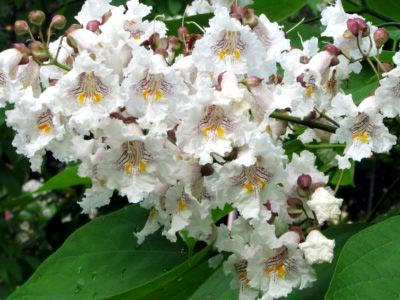

Catalpa - pasta tree
Catalpa is a tree whose fruits resemble long icicles. In fact, they are green pods, inside of which there are a large number of seeds that are vaguely similar to dandelions and scatter in different directions after opening. It is because of such pods, reaching a length of 35-50 centimeters with a width of about 1.5 cm, that the catalpa is also called "pasta tree" for the similarity with pasta or spaghetti hanging from the branches. In the absence of winds, the fruits can hang on the tree all winter.
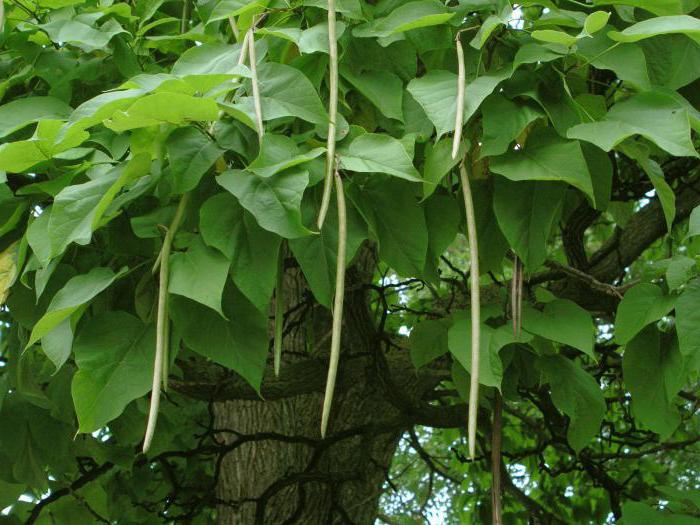

Catalpa is a tree that is characterized by a straight trunk and gray bark with thick blades. Certain wild-growing forms are a source of valuable wood, which is similar in characteristics to oak wood.
Catalpa transplant
Catalpa is transplanted in two cases: if an adult tree has grown and there is not enough space for it on the site, or if it is necessary to transplant a young plant from a pot into open ground. A tree transplant can be carried out both in the spring before the sap flow begins, and in the fall, when the tree will drop its foliage.
It is better to replant a tree together with a clod of earth with which an adult tree or a young seedling grew before. The planting hole is dug to the same depth as when planting the catalpa, the composition of the soil mixture also does not change. After transplanting, it is necessary to compact the soil and water the plant abundantly.
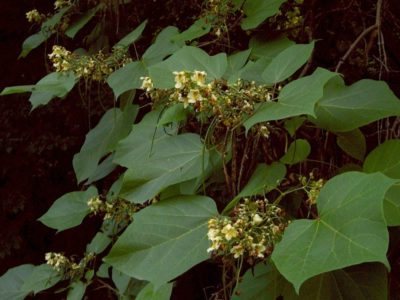

Planting culture
For good growth and development, seedlings need a lot of light, they can be grown in partial shade. The site should be fenced off from strong winds, and the soil should be:
- loose;
- easy;
- drained;
- fertile;
- moisturized;
- neutral or slightly acidic (6, 5 - 7, 5 pH).
The optimal period for planting a crop is early spring before the time of sap flow. First, you need to dig a hole 70-120 cm deep, and then prepare the planting stock from:
- river sand;
- humus;
- peat;
- sheet soil.
A drainage layer of 15 cm from crushed stone or broken brick is poured into the planting pit, then phosphorite flour, wood ash, prepared soil are added. A plant is installed on top, the free space is filled with the remaining soil, it is tamped, watered and mulched with peat.
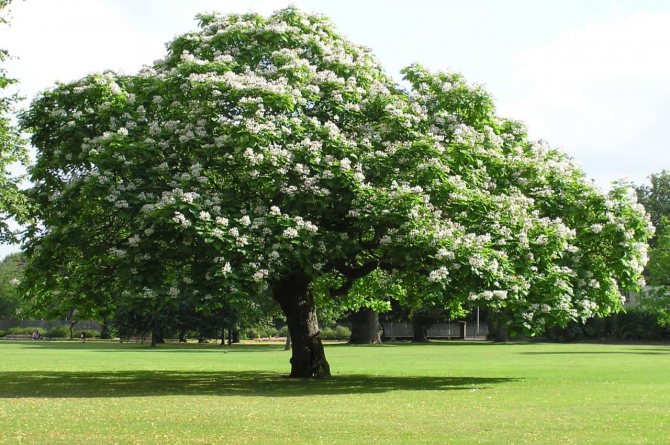

Feeding catalpa
The tree should be fertilized systematically. For this purpose, a solution of rotted manure diluted with water in a ratio of 1:10 should be added to the soil where the catalpa grows. An adult tree needs 6 liters of such feeding, and a young seedling from 2 to 3 liters.
Top dressing is carried out twice a season. In the spring, nitroammofosk is added to the soil under the tree, and in the fall - phosphorus and potassium fertilizers, since at this time the plant needs nitrogen.
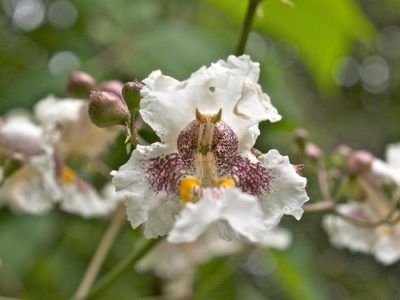

Catalpa: the original tree
There are only 13 varieties of such a tree, and catalpa in the Moscow region is grown in only 4 species.
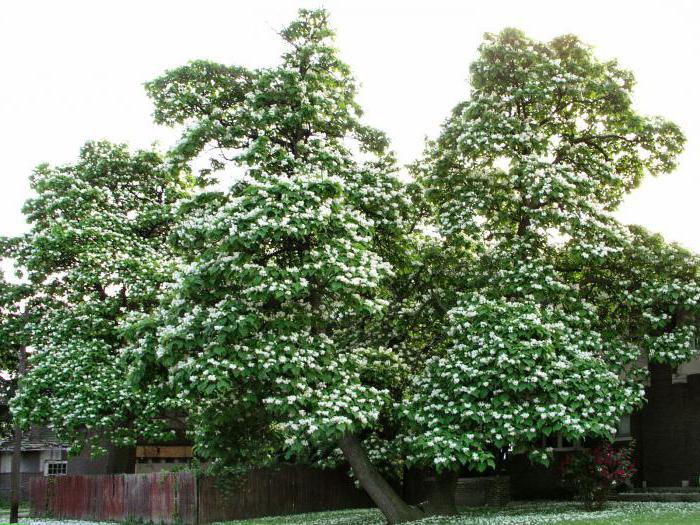

Catalpa appeared in Russia in the middle of the 19th century. And it was originally grown in botanical gardens as an exotic plant.Gradually adapting to the climate of the Russian regions with their harsh winters, catalpa has become widespread and calmly tolerates temperatures of -25 degrees. Catalpa, whose photo fully conveys the beauty and originality of this unusual plant, has another name - "tree with elephant ears", which she received for the large heart-shaped leaves. In Indian tales, they personified the hearts of warriors. A feature of the catalpa is the preservation of the greenery round and very shady due to the large size of the crown leaves almost until the very frost.
Flowering catalpa
Catalpa buds appear in late March - mid-April. It all depends on which strip of Russia the tree grows in. The flowering period begins in mid-June and lasts about a month.
The flowers of the catalpa resemble exotic and beautiful small orchids, which smell like apple flowers. The flower petals have wavy edges and a white or cream shade with yellow stripes and purple specks in the throat. The size of the flowers reaches 7 centimeters. They are collected in large and long inflorescences that resemble "candles" of chestnuts.
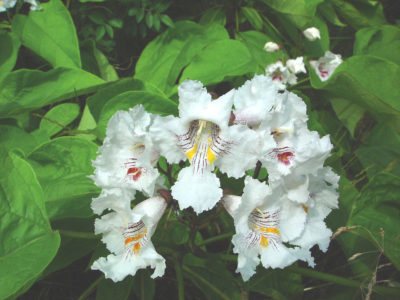

Description
The culture of the Catalpa genus of the Bignonius family was introduced at the beginning of the 18th century by Carl Linnaeus himself. In natural nature, the tree is distributed in the American continent, the Caribbean and in Asia.
In natural conditions, it often appears to be very large trees, the height of which can be 20 - 40 meters. However, it has the ability to grow as a multi-stem shrub. In nature, it usually grows in damp places, along rivers and other bodies of water.
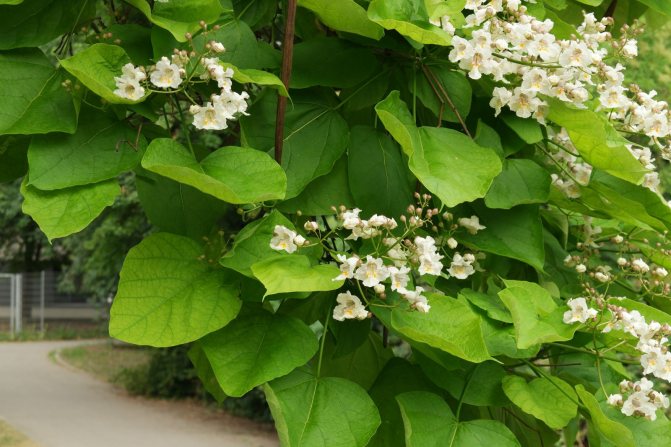

The culture has large heart-shaped leaves, it is very decorative in any season. At the end of June, the whole plant is covered with snow-white or cream flowers, tubular in shape or similar to slightly swollen bells. An unusual look is given to them by the darkest, often pink-purple, scarlet or brown spots and dots. The size of the flowers varies from 2.5 to 7 cm. The flowers are arranged in large clusters and have a pleasant aroma. In autumn, the trees are ripening longish, from 0.2 to 0.4 m fruits - boxes, which are similar in shape to pods.
Catalpa pruning and shaping
Catalpa pruning is carried out in the spring, until the buds swell. When pruning, only injured, dry, frozen branches or branches damaged by diseases or pests are removed.
Usually the tree is formed, creating a bole with a height of 120 to 200 centimeters, above it the tree will branch out, forming a spreading, low crown, consisting of 5 skeletal branches.
After a certain period of time, if necessary, the skeletal branches are shortened, and the thickening stems are removed. As a result, a dense, beautiful rounded crown with light green leaf plates is formed.


Catalpa care rules
Since the catalpa is a southern heat-loving tree, in our latitudes it has a need for care. There is practically nothing difficult about this, the standards are easy: watering, frost protection, weed control and parasite control. But in the first 2-3 years after planting, care must be paid close attention, since a young, not yet fixed tree is exposed to some fatal factors.
Watering
After planting, the seedling must be watered constantly, at least 1 time per week, and in a dry hot period - as needed, after the soil has completely dried out. Pour 1-2 buckets of water each time. A mature tree also needs regular watering with the same period, and more water will be required. But beware of stagnant water in the trunk circle. If necessary, make a drainage, breaking the groove in the direction from the tree.
Fertilizer
Catalpa does not need to be fertilized for a certain time after planting.The soil mixture in which the tree was planted is very nutrient-rich. After 1-2 years, fertilize the plant at the beginning of the growing season with manure in the ratio of 1 liter to 20 liters of water. Each seedling will need 1 bucket of solution.
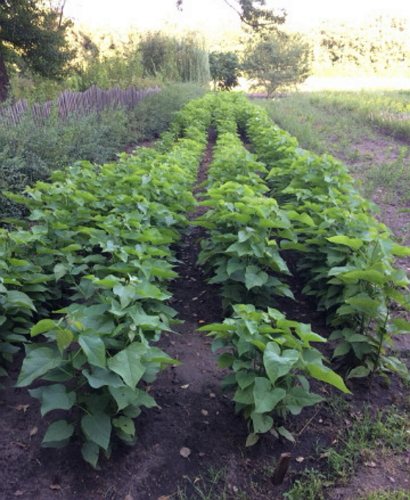

Top dressing of a mature tree is performed 2-3 times during the growing season. For this, you will need a manure solution in a ratio of 1 liter to 10 liters of water. To feed any tree, you will need 5–6 liters of solution, the first time - at the beginning of the growing season, the next - in its second half. During the flowering period, pour in a one-time mineral fertilizer according to the instructions after watering the plant.
Pruning and shaping the crown
Under the weather conditions of the middle region, vegetative activity in catalps occurs later than in other plants. The growth of seedlings after planting is slow, leaves begin to form only in May, flowering begins at 5-7 years. For this reason, the catalpa needs pruning, the main healing method, during which diseased and frozen branches will be destroyed.
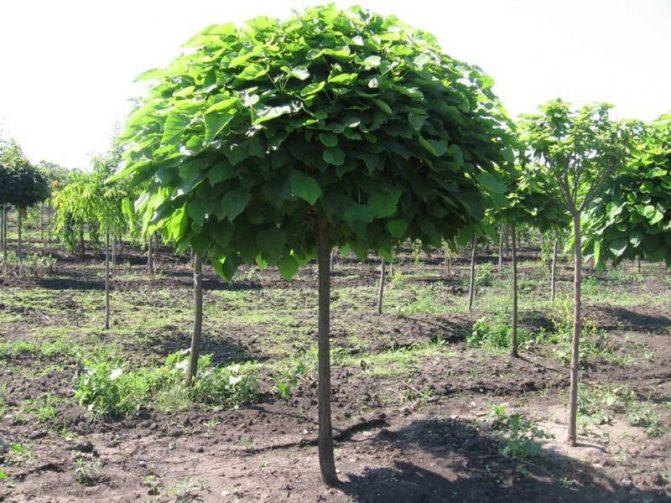

The best time for curative pruning of catalpa is early spring, before the start of the swelling of the buds. Affected branches are cut to a level just above the last living bud. In late spring and early summer, formative pruning should be done. The height of the trunk must be 1.2–2 m, from this site the catalpa must branch into 4–5 skeletal branches, producing a low, spreading crown. Over time, the skeletal branches can be shortened, and the thickening processes cut out.
There is no need to fear that pruning will ruin the shape of the crown. Catalpa is very rapidly renewing, building up young shoots with a huge number of leaves.
Preparing for the winter period
Before the arrival of frost, wrap young catalpa seedlings with sacking or spruce branches. Mulch the soil around the trunks with a layer of leaves. In the spring, take off the insulation as soon as warm weather reigns, and loosen the ground well: the above will help avoid the appearance of fungus.
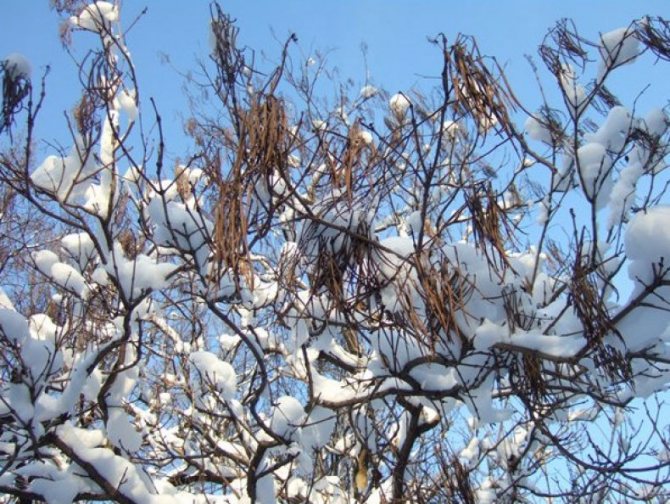

If the winter is severe and severe frosts come, immediately cover the seedlings completely. It is possible to cover them with burlap or a huge amount of spruce branches. In a couple of years, as soon as the catalpa grows and becomes completely stronger, the need for preparation for winter will disappear.
Preparing catalpa for winter
Catalpa does not tolerate cold well. Young trees are especially "afraid" of them. For this reason, the tree should be prepared for winter in advance. For this purpose, it is necessary to wrap the trunk with burlap, and cover the soil around the tree with a thick layer of dry foliage and cover it with spruce branches. Thus, it will be possible to avoid freezing of the root system. With the onset of spring, when the frosts have completely stopped, the tree is freed from shelter.
It should be borne in mind that as it grows and develops, the catalpa becomes more and more frost-resistant and tolerates winter better. The most frost-resistant variety is the egg-shaped catalpa, and the weakest, freezing almost to the base, is the Aurea catalpa. However, this variety is capable of completely regrowing over the summer.
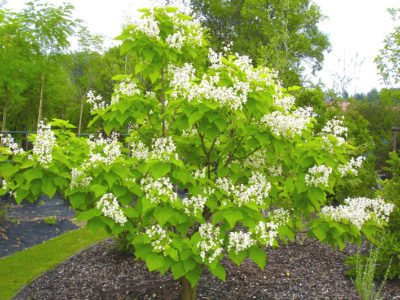

Brief conclusions
- Catalpa is an ornamental culture native to the southern regions. Having spread over the territory of the middle zone, over time, it adapted to cold winters, and is now able to delight gardeners from different parts of the country with its beauty.
- To grow the plant, use the seed method or propagate it by cuttings. When the crops are strong enough, they are planted on the site, choosing a well-lit place, protected from drafts. The soil here should be drained and fertile, with medium or neutral acidity.
- The seedling should be properly looked after, in this case it will be possible to avoid the development of diseases, the appearance of parasites, it will actively grow, please with lush flowering. It is imperative to ensure timely, abundant watering.
- We must not forget about regular feeding and sanitary pruning, and shaping the tree will create a beautiful crown.Young seedlings need careful shelter before winter. Only with its help will they be able to survive the cold and continue to delight others with their splendor.
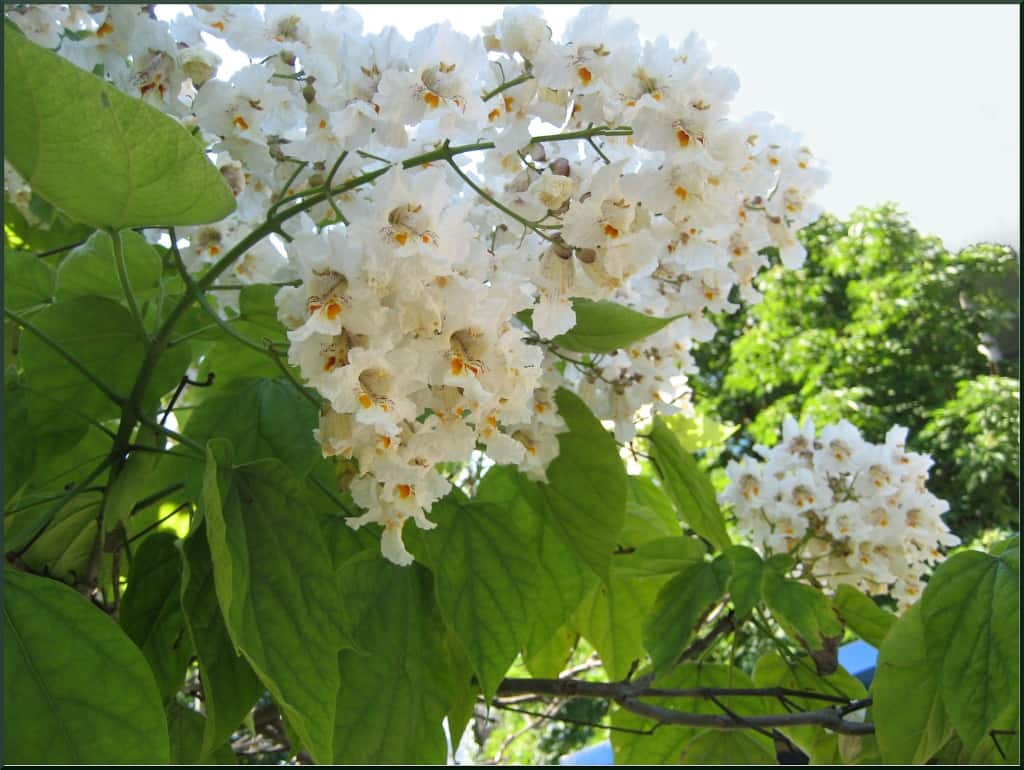

Catalpa from seeds at home
When growing catalpa from seeds, you should first stratify them. It is necessary to sow seeds at the end of February, beginning of March. Before sowing, the seeds should be soaked in warm water for 12 hours. You can also sow them in the fall, but in this case, you do not need to soak the seeds.
In the prepared soil, small grooves are made into which the seeds are laid out and sprinkled with a layer of substrate. A box with seedlings, cover with a layer of film and put away in a lighted, warm place. The temperature for good germination of seeds should be at least 25 °.
Crops must be protected from direct sunlight, systematically watered and ventilated. The seedlings that have grown in a year can be planted in open ground when the threat of frost passes.
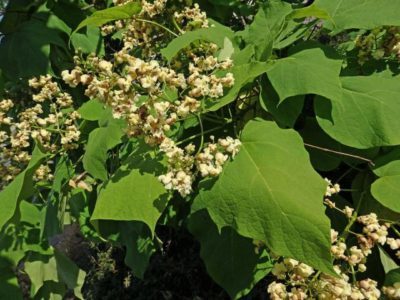

How catalpa reproduces
Catalpa care and cultivation is very similar to the usual garden plants. Reproduction of exotic culture is no exception. It is carried out with seeds, green cuttings of the first year, and even layering.
Reproduction of catalpa by cuttings
The easiest way to get the desired amount of planting material, while completely preserving the specific characteristics of the plant, is green cuttings. The survival rate of cut catalpa shoots is estimated as 50/50. With good moisture content of the substrate, it is possible to preserve almost all the seedlings.
Young shoots up to 10 cm long are cut at the end of summer and buried in moist soil up to half. According to gardeners, there is no need to treat cuttings with stimulants. Roots appear quickly. Signals that the planting has taken root, the appearance of a fresh growth. In the spring, plants can be planted permanently in the garden.
Reproduction of catalpa by seeds
Home-grown catalpa has several benefits:
- the ability to get any number of seedlings due to the high fertility of the culture;
- undemanding plants in care;
- high winter hardiness of seedlings.
With the indicated germination rate of about 10%, in practice it is possible to obtain a much higher yield of seedlings. But the method also has disadvantages. Seeds of a tropical tree do not always have time to ripen before the cold weather. This is especially true of late flowering catalpa species.
Among the advantages of cuttings are called a more even formation of the trunk in trees and an early entry into the flowering phase (in the 2-3 season). But this method produces plants that are vulnerable to frost in the first year after planting.
Catalpa propagation by cuttings
When growing catalpa using cuttings, planting material should be harvested in July. The cuttings should be 8 centimeters long, and they must also have from 2 to 4 buds. When preparing material for planting, you should choose an adult catalpa.
In order for the roots to appear on the cuttings, they must be planted in the ground, which will include peat and sand, then cover the box with the cuttings with foil and remove to a warm and bright place. The hoopoe behind the cuttings should be the same as behind the seedlings. When the cuttings take root, young foliage will appear on them. Planting ready-made young stock in open ground can be done in mid-May.
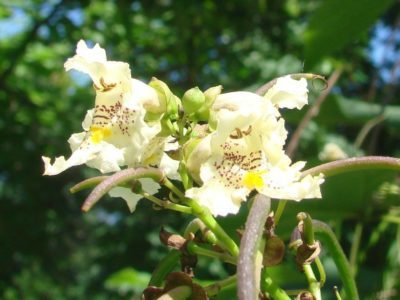

Breeding methods for catalpa
Many people who are engaged in breeding catalpa often begin to think that it's time to breed a couple more of these trees. After all, they brighten up the adjoining and park areas throughout the whole year and have practically no problems in leaving.
Catalpa can be propagated by 2 methods: vegetatively, that is, by cuttings or using seeds. Prepare your planting base according to the following list and start copying the plant.
Planting soil for seeds and cuttings of catalpa:
- 500 gr. sand.
- 500 gr. black soil.
- 250 g peat.
- 750 gr. humus.
Vegetative method
In order to get young catalps with the help of cuttings, first they need to be successfully prepared, and then planted in the ground for rooting.
- In the second part of summer (from the end of July to the 1st of September), look for shoots of 10 - 15 cm in size with 3 - 4 buds on the tree.
- Cut them carefully using a sharp knife or special pruning shears.
- Prepare a box filled with potting soil for the cuttings.
- Plant the cuttings in the ground for rooting. In order for the shoots to form a root system earlier, before settling in the ground, it is recommended to treat them with special preparations-growth stimulants, for example, it is possible to use "Kornevin".
- Place the box of cuttings in a room with a light, stable temperature. When the soil dries, water the plantings carefully. Do not allow excess moisture in the ground.
- During the winter, the cuttings will take root in the spring, after making sure that the cold does not return, it will be possible to plant them in open ground.
Seed method
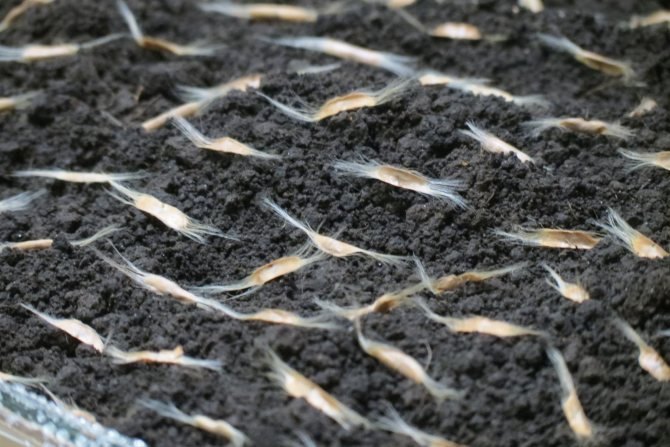

- In autumn, after the formation of the pods, remove the seeds from them. You can keep catalpa seeds in a dry and cool place for no more than 2 years. For this, small linen bags or paper bags may be most reliable.
- It is necessary to sow seeds in February-March, soaking them in warm water for 10 - 12 hours in advance to increase germination.
- It is imperative to provide the seedlings with greenhouse conditions. For such a box with landings, it is possible to cover it with a transparent film, a piece of glass, or place it in a plastic bag.
- Place the makeshift greenhouse in a warm, sunny place. Ensure planting with mild moisture. In such good conditions, the first shoots are formed in 3-4 weeks.
Planting seedlings in open ground
The most optimal period for planting such plantings in the garden is spring. But sometimes landing in the autumn is also allowed. A sunlit place is good for planting a catalpa, but this tree can just as well grow in the shade. These trees look great near garden paths, near a pond or in the center of a lawn.
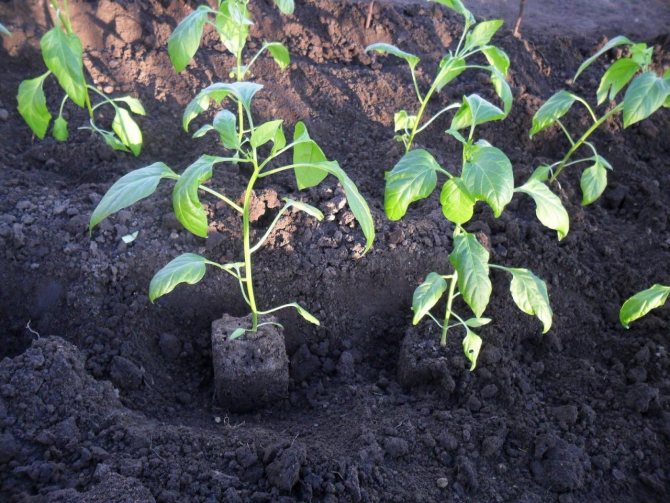

This culture is not very demanding on the soil, but it loves moist, not too acidic, rich in organic matter and drained. The best time for disembarkation is early spring. To plant the seedlings, you need to dig a hole approximately 0.7-1.2 m deep. In the case when several trees are planted at once, you need to maintain a distance of 3 meters between them.
When creating a planting base, it is necessary to mix river sand, leafy soil, peat, humus in a 2: 2: 1: 3 balance. In addition, add wood ash and phosphate rock to the prepared hole. Attach the seedling to the resulting mixture, bury it, water it perfectly and mulch the surface with peat. The root collar of the tree must be level with the ground. For this reason, when planting a crop, it is necessary to take into account the upcoming subsidence and compaction of the earth.
Diseases and pests
Catalpa is resistant to both diseases and pests. But as long as the tree is young and weak, it can be attacked Spanish fly... To destroy the pest, it is necessary to spray the young catalpa with the insecticide "Decis" or "Fastak".
Also, a young plant is threatened and horn-tails, which settle on the trunk and in their appearance resemble hornets. They bite through the bark and lay eggs there, and when the larvae hatch, they begin to feed on the catalpa, as a result of which it weakens and dries up. Adult trees are not threatened by an invasion of staghorn. Spraying with Actellik insecticide will help to destroy this insect.
Catalpa can get sick verticillary wilt, which primarily affects the lower part of the crown, and then covers the entire foliage. With verticillosis, the leaves begin to turn yellow, wither and fall off. It is possible to get rid of this disease of fungal ethology with the help of irrigation with such preparations as "Maxim" and "Rovral". The crown can be treated with "Fundazol".For prevention, the plant is sprayed with "Previkur".
Exotic catalpa will adorn any garden plot, bringing originality and aesthetics to the overall landscape composition. And with proper care of the tree, it will delight for a long time with its decorative effect and unusual delicate flowers with a pleasant apple aroma.
Catalpa in landscape design
The rapid growth of trees, as well as exceptional decorativeness at any time of the year, have made culture a favorite with gardeners and landscape designers. Plants are used in single, group plantings, form alleys. In the urban landscape, trees adorn the areas in front of office, residential buildings, shops. Resistance to a gaseous atmosphere allows you to decorate not only squares, but also sidewalks or roadsides of major highways.
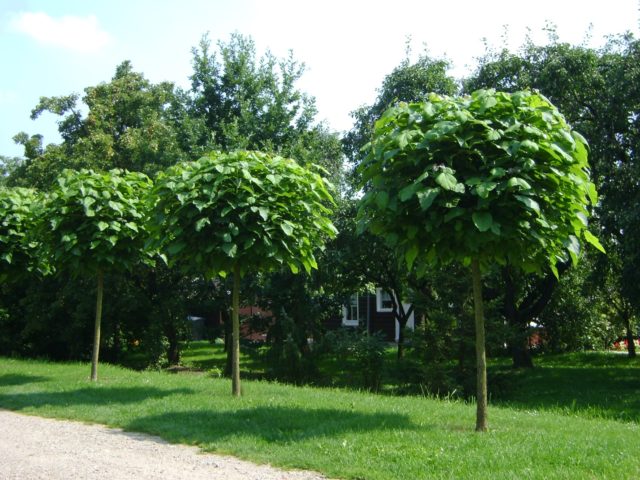

The combination of several plants of different species with flowers or leaves of different shades increases the decorativeness of the plantings. Catalpa, surrounded by a hedge or border of cotoneaster, boxwood, hawthorn, creates a composition that is decorative all year round.
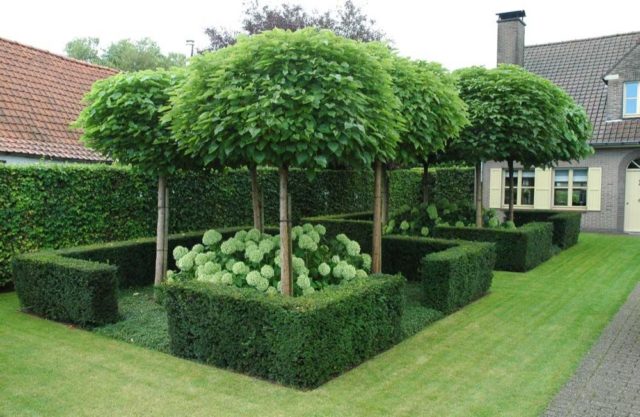

In small areas, a large catalpa (magnificent or bignoniform) creates the main accent and serves as the center of the entire garden composition. In large gardens, planting culture next to oak, paulownia, magnolia, coniferous trees is successful.
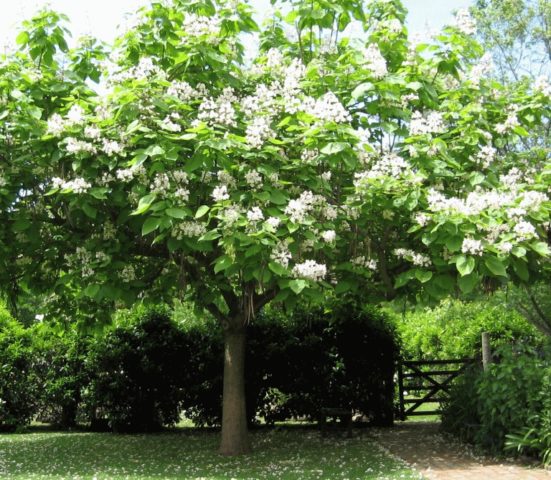

Fragrant flowering plants are excellent melliferous plants, the leaves emit volatile compounds that repel blood-sucking insects, and the tent crowns of trees provide a very dense shade. Thanks to such advantages, the tall catalpa very quickly became a favorite in private gardens, in courtyards and outdoor recreation areas.
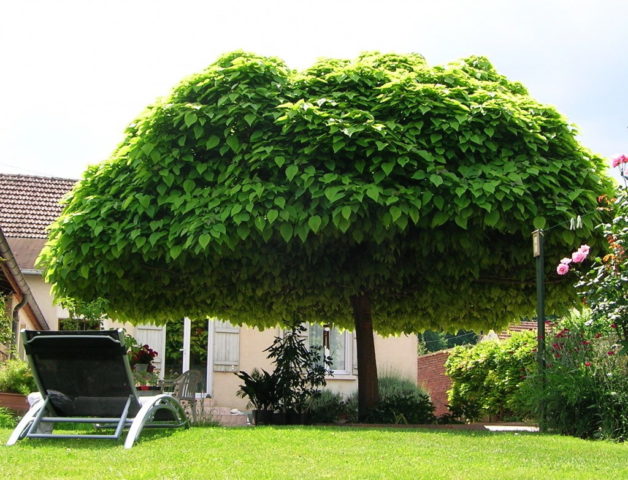

The roots of the plant perfectly penetrate and hold the soil, which serves to anchor the loose banks of reservoirs.
Catalpa on a trunk in landscape design perfectly frames paths, complements flower beds, leaving space for ornamental grasses, primroses, host, shrubs. For low, neat accents, use Catalpa Nana. If you want to create a more voluminous composition, decorate a hedge or a high fence, a hybrid type of catalpa is more often used.
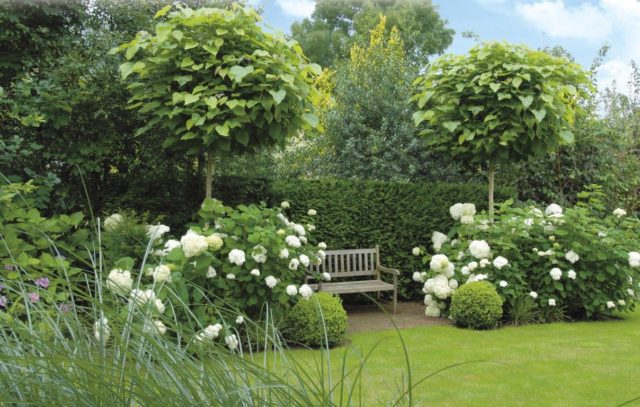

Features of this plant
- Decorative catalpa is a nice looking low (no more than twenty meters) tree with a rounded crown. More than half of the catalpa species have opposite leaves. But among them there are also whorled ones. The petioles of the leaves are long, and their size is about 30x17 centimeters. The flowering of the catalpa is spectacular. The white / creamy flowers are about seven centimeters in size and smell nice and have a dark speck in the throat.
- The flowers are composed of paniculate inflorescences. The fruit is a hanging box with a length of four to five and a half tens of centimeters. They contain a colossal variety of flying seeds. It begins to bloom in the second half of June or in the very first days of July. There are regions in Russia where catalpa fruits fall only in spring.


Catalpa blooms with white or cream funnel-shaped flowers
Collection and procurement
Leaves and flowers of the plant are collected for medicinal purposes, sometimes bark is used - it contains tannins, resins and essential oils. The flowering period in Asia occurs in early May, while in late spring regions it can be late and begin around the end of May or early June. See the rules for collection and procurement below.
- Bark - used dry and fresh, decoctions are prepared from it for medicinal purposes. Bark can be harvested throughout the season, but the best time is from May to August. During this period, the bark is most useful, and the plant will have time to recover from such an intervention before winter. The bark is collected only from mature trees that are more than 5 years old.
- Flowers are harvested in season - from late May to mid-June. They are dried in a room that is well ventilated and does not contain strong odors. The flowers must be crushed and stored in an airtight container.
- The leaves contain the maximum concentration of valuable substances from early to mid-summer. At this time, they are cut, dried, and then crumbled and also stored in an airtight container.
The roots of the plant are not used due to their high toxicity. It is not even recommended to work with them without heavy gloves. Vegetable raw materials are suitable for use within 1 year from the date of collection.
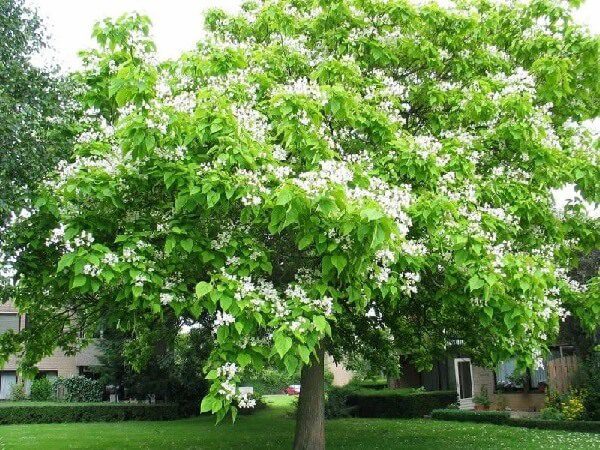

Useful properties of catalpa
The use of the bark, leaves and flowers of the tree for medicinal and other useful purposes has a long tradition. In America, the plant has been used since the time of the Aztecs. They were treated for respiratory ailments, including consumption, and for skin diseases. In ancient times, using the raw materials of the "tree of happiness", malaria, whooping cough were treated, and worms were expelled. Modern herbalists recommend catalpa leaves and flowers for cosmetic use. Bark tinctures can help with internal inflammation.
The medicinal properties of catalpa are also used in veterinary medicine. Animals that are mixed with catalpa leaves in the feed are less susceptible to disease. However, as powerful and useful as these tools can be, they can also harm if used improperly. Therefore, you should not self-medicate with this plant. Moreover, its underground part has much stronger and even poisonous properties, the consequences of which can even be fatal.
Catalpa roots are poisonous! It is forbidden to use them for medicinal purposes, because an illiterate handling of raw materials can have the most serious consequences.
Botanical description
In the wild, many species grow on fertile moist soils, reaching 20 m.Taller specimens, up to 25 m, are also found. In culture, these are large shrubs, compact or medium-sized trees. Their root system goes several meters deep and is sensitive to any mechanical damage. Trunks are rarely linear; in arboreal forms they are rather massive, branched. The bark is dark gray, lumpy, with deep cracks. Lateral shoots are long, widely spaced from the trunks, forming a powerful crown.
The leaves are simple, large, heart-shaped, green, with elongated thin petioles, solid edges, pointed tops. Located opposite or whorled. The size of the leaf blades is up to 30 cm in length, about 15-18 cm in width. Outwardly they resemble elephant ears. On a smooth or slightly rough surface, a network of thin veins is clearly visible.
The flowers are bisexual, about 2–3 cm in size, funnel-shaped, bell-like. Petals with a tubular accrete base, lobes bent outward. Coloring cream, white, peach, pink. The pharynx is decorated with contrasting dots. The stamens are bright yellow. Corollas are collected in racemose paniculate inflorescences of 10–25 pcs. Catalpa shape, shades of petals resemble chestnut.
Read also: Herb shiritsa ordinary: description, useful properties, application
The plant begins to bloom in mid or late June. The crowns of trees and shrubs during this period are covered with a thick veil of petals, the delicate aroma attracts the surrounding bees. Plants are excellent honey plants.
The fruits are formed in August. These are thin green pods up to 40 cm long, hanging from the branches. Under the shell are many small, lightweight seeds with wings. The pods can persist in trees throughout the winter.
How does catalpa reproduce?
Judging by the photos and descriptions, the catalpa tree, with proper planting and care, multiplies quite quickly. Mostly this happens with the help of seeds and in a vegetative way. Quite often, gardeners, after successfully growing one tree, consider buying or growing several more.
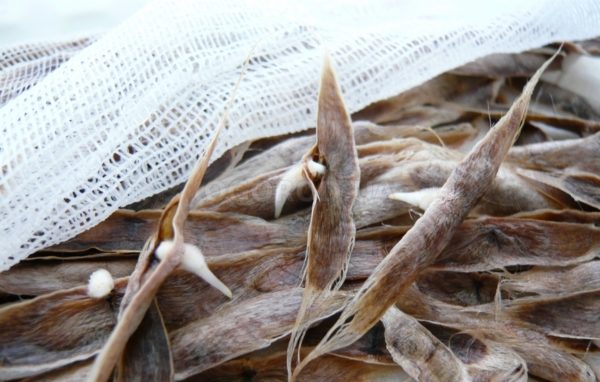

Having tried to plant catalpa once, many come to the idea of how to grow a whole garden of these beautiful exotic trees.This can be done if you know the features of the reproduction of a tree of this species. You can choose the most convenient way - use seeds, or cuttings from already grown trees.
Important!
Before you start planting, prepare a special substrate that will help the tree to become rooted in the soil and begin to grow vigorously.
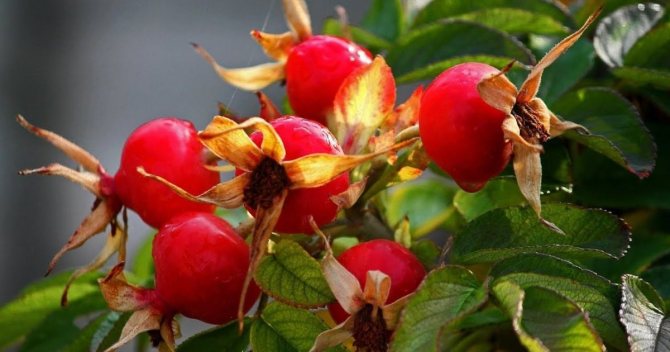

You may be interested in:
Rosehip - useful properties and contraindications for women and men Rosehip is a fruit bush, the leaves and berries of which are used in folk medicine and cosmetology. Of these ... Read more ...
The planting substrate includes components such as:
- river sand;
- a small amount of fertile soil, preferably black soil;
- peat;
- some humus or organic manure.
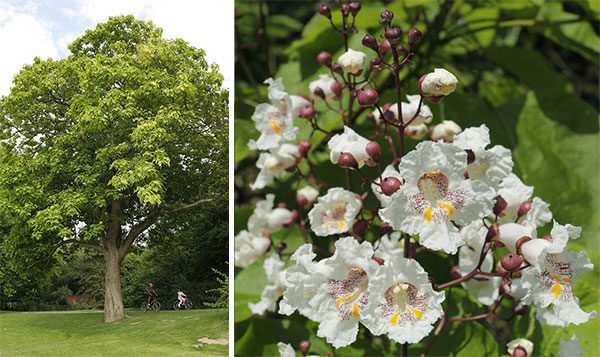

Success secrets
Catalpas are thermophilic plants and grow best in southern regions. In the middle zone and to the north, they need to be protected from frost in the first years of life. The trunk can be covered with spruce branches or non-woven material, the near-trunk circle with foliage. As they grow older, winter hardiness increases, and the need for shelter disappears. Even if the tree freezes, it will quickly recover with the arrival of heat.
Catalpas are watered in the spring and summer season. Mulching will help to reduce the number of procedures. The soil must be periodically loosened and weeds removed.
Trees are fed in the spring with nitroammophos, potassium-phosphorus fertilizers are applied at the end of summer. During the growing season, they are fed twice with a solution of rotted manure (1:10).
Sanitary pruning is carried out in early spring, removing frost-damaged shoots.
Content
- 1. Description 1.1. Popular types
Catalpa (Catalpa) is a small genus consisting of 11 species in the Bignonium family. Deciduous and evergreen trees grow in North America, China, Japan, Cuba. In nature, they live up to 100 years, reaching 30 m in height.
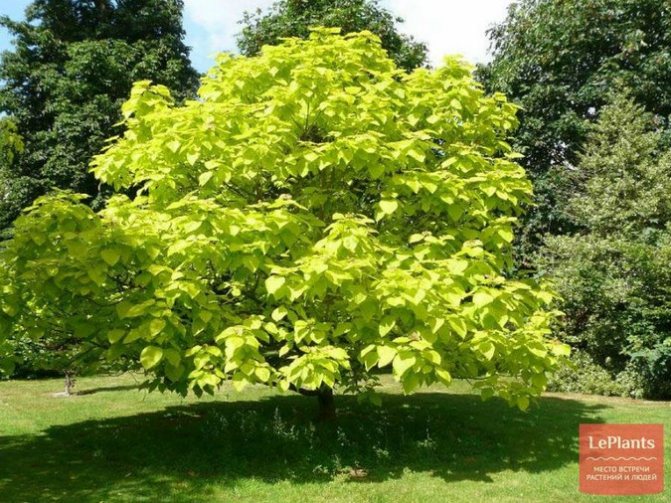

Plants have a taproot system that penetrates to a considerable depth. Catalpa grows most actively during the first 40 years of life, then growth slows down. The bark of trees is colored light brown, at first it is smooth, as the plants mature, it becomes scaly.
Catalpa has a spreading crown, tent-shaped. Branches in the upper part are ascending, in the lower part - open. The shoots are densely leafy.
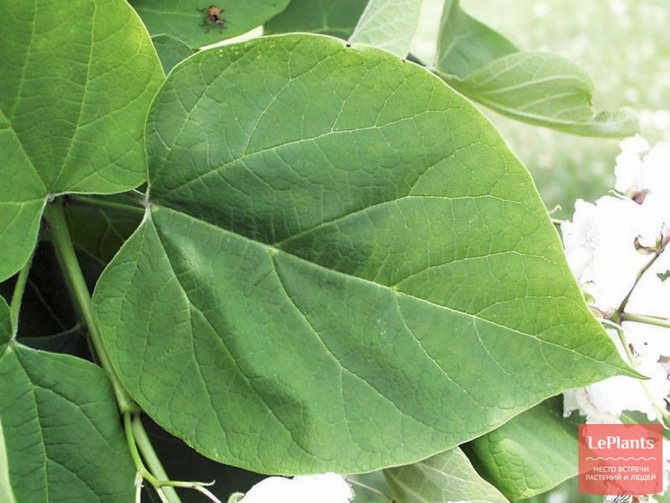

IN THE PHOTO: Large leaves of a heart-shaped or ovoid form sit on long petioles, are arranged vertically or oppositely.
In summer, beautiful flowering is added to the decorativeness of the foliage. At the tops of the shoots, large funnel-shaped flowers, collected in panicles or brushes, bloom. Their corolla is white or cream colored, the throat is decorated with dark strokes and spots.
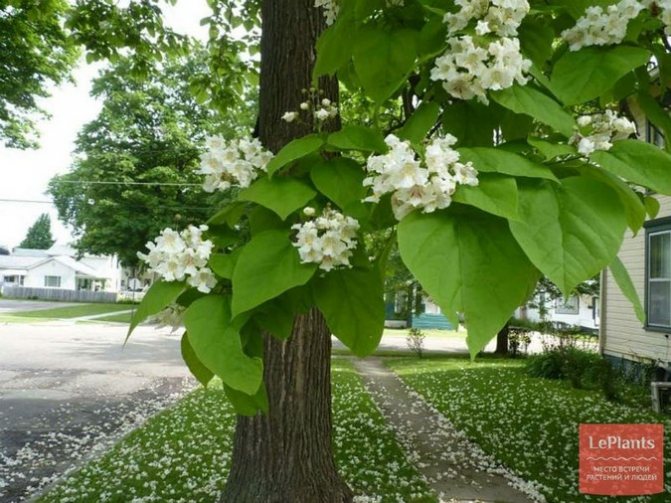

ON THE PHOTO: Catalpa flowers smell very nice.
After flowering, fruits appear - long narrow capsules filled with winged seeds with a tuft. These "pods" remain on trees throughout the winter, giving originality to the plants.
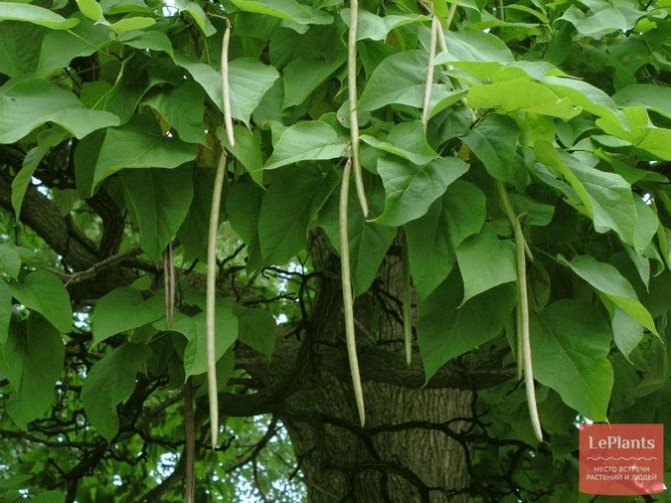

Popular types
Catalpa has been cultivated in culture for several centuries. The most common species is C. bignonioides.


IN THE PHOTO: A short plant is often a tree with 2-3 trunks or a spreading bush.
Among the bred forms and varieties, the most popular are:
Catalpa bignonioid 'dwarf' (C. bignonioides 'nana'), the height of which does not exceed 4 m.
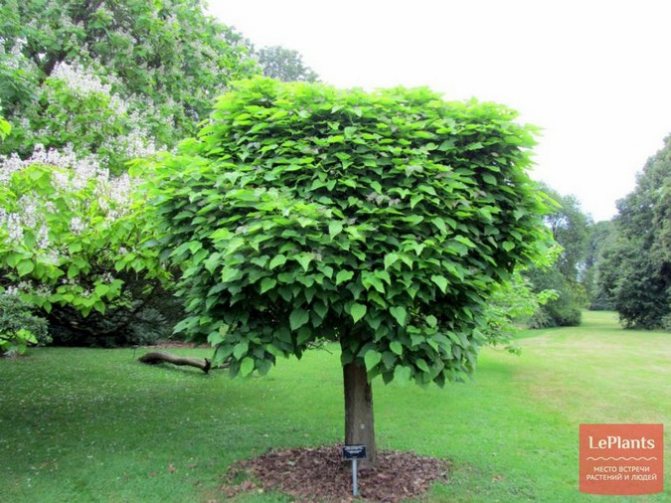

ON THE PHOTO: The plant is characterized by a slow growth rate, suitable for the formation of a stem.
Catalpa bignonium ‘golden’ (C. bignonioides ‘aurea’) with yellowish-green foliage.
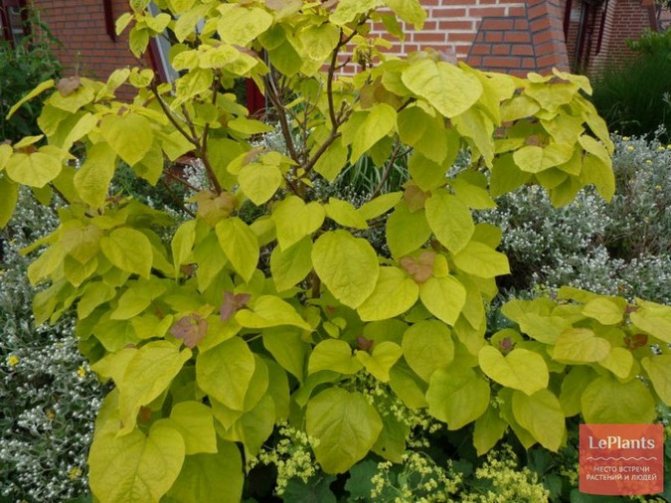

IN THE PHOTO: Catalpa bignonioides ‘golden’ (C. bignonioides ‘aurea’).
Catalpa bignonioid 'Kene' (C. bignonioides 'Koehnei'), the leaf blades of which are decorated with a green insert.
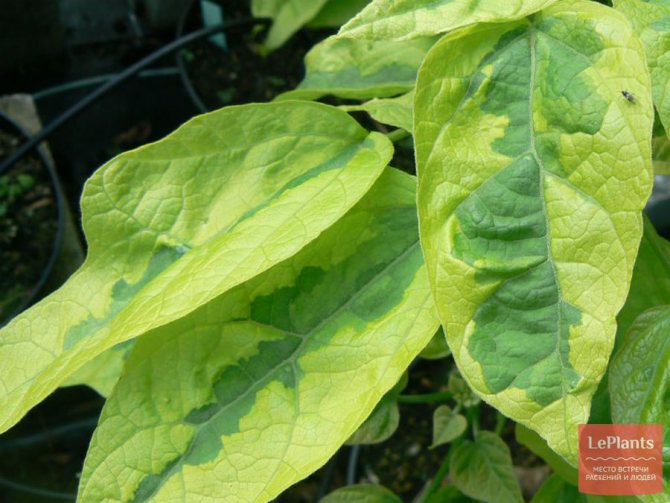

IN THE PHOTO: Catalpa bignonioides ‘Kene’ (C. bignonioides ‘Koehnei’).
Catalpa ovate (C. ovata) is distinguished by three-lobed dark green leaves and yellowish flowers.
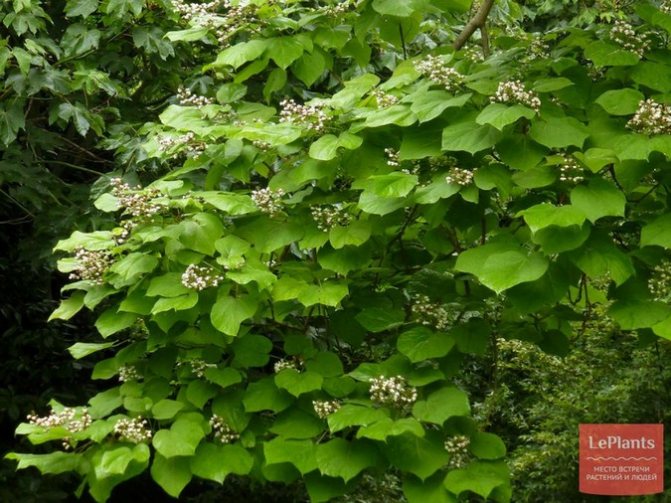

IN THE PHOTO: Due to the shortened growing season, the shoots of Catalpa ovoid are lignified before the arrival of frost.
Beautiful catalpa (C. speciosa) is a frost-hardy species that dissolves young foliage earlier than others.
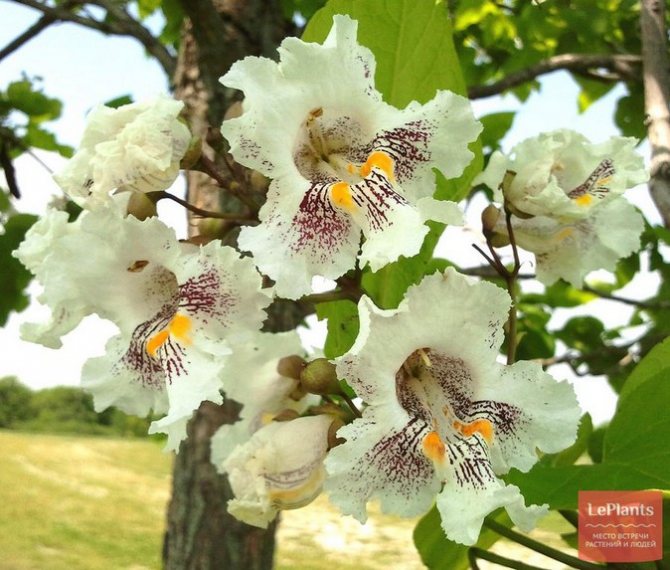

IN THE PHOTO: Multiple flowers of the beautiful Catalpa keep on the branches from 2 weeks to a month.
Catalps are suitable for group compositions and single plantings. Trees are recognized as excellent melliferous plants and are resistant to air pollution. It should be borne in mind that plants begin to bloom at the age of 5 years.
Briefly about planting and growing catalpa
This plant blooms for the first time in the fifth year of growth. The flowering itself occurs from three to three and a half weeks, starting from mid-June to early July inclusive.
Catalpa should be planted either in spring or in October. Well, in the first option - until the moment when the sap flow begins.
Important! Catalpa needs bright sunlight.
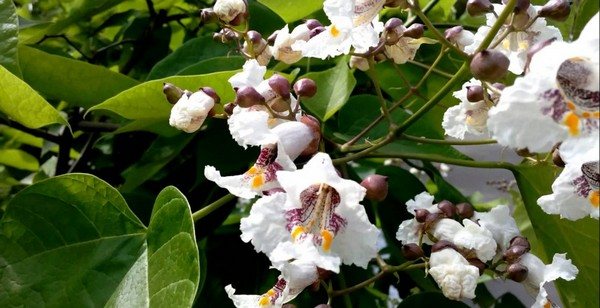

Catalpa begins to bloom only in the fifth year of life.
The pit for planting such a plant must be filled with a mixture.
| Ingredient | number |
| Humus | 3 parts |
| Sand | 2 parts |
| Leaf land | 2 parts |
| Peat | 1 part |
You need to water the catalpa every week, and even more often in a drought. Each time you need to use two buckets for each adult plant. But with a relatively cool season, abundant in the rains, you can water it a couple of times a month.
Fertilizers need to be applied several times per season. At the same time, twice during this period, it is necessary to make from five to six liters of a ten percent solution of rotted manure. In the spring, you should feed the plant with nitroammophos, and in the fall with fertilizer containing potassium and phosphorus.


It is better to water such a plant often, especially in drought.
Important! Decorative and preventive pruning is recommended in the spring, before the buds begin to bloom.
This tree propagates by seeds and cuttings.
Parasites are horn-tails and spanish flies.
It sometimes suffers from verticillary wilting.
Next, we will analyze everything that the owner of the catalpa needs to know in more detail.
Species diversity of the plant
Several types of tree are often used in landscaping gardens. In order to navigate the views and imagine how they look, as well as know their nuances, consider the types:
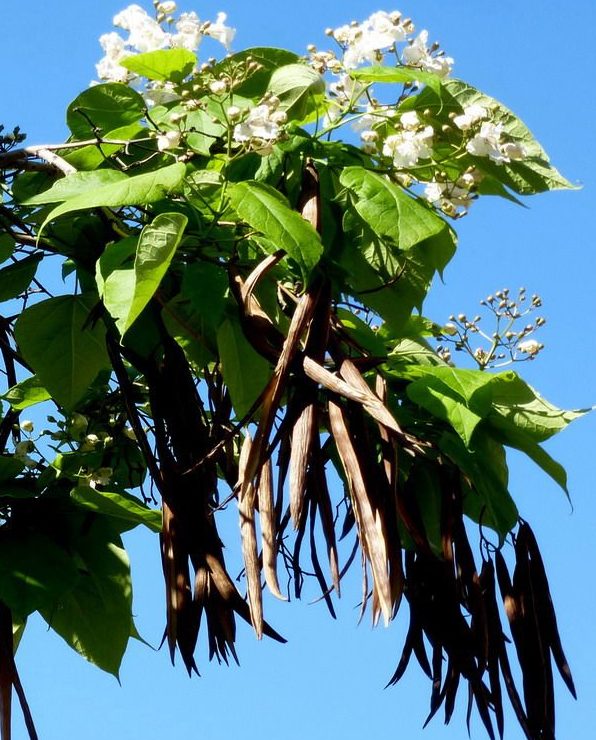

The catalpa is beautiful - the crown of this tree is thin-lamellar, the height can reach as much as 45 m.The wonderful catalpa is distinguished by the fact that the color of its trunk is gray, the leaves are also quite large - 40 cm in length and 20 cm in width, the top is smooth, light green, and the bottom is white and lowered. Its flowers are white-cream in color with small purple dots inside, which are dissected by yellow lines. The inflorescences emit an intoxicating aroma that will blow throughout the entire flowering, which lasts up to 25 - 30 days. However, it will begin to bloom only after reaching 10 years. Its fruits are in the form of boxes, inside of which the seeds are stored, they can be seen already in the middle of summer. Reproduction takes place in various ways: by seed, cuttings or by layering. Grows in moist, mineral and fertile soils. Transplanting for a tree does not provide side effects, the plant tolerates it well, and planting should be done in early spring. This species is more frost-hardy than others. It is used both as a separate tree and in the design of group plantings of squares and alleys.
How to care?
Catalpa loves moisture, and therefore, we emphasize, she needs a weekly watering of twenty liters of water each time. With a lack of moisture, the catalpa becomes much less beautiful - its foliage becomes less elastic, begins to sag. In hot dry weather, especially for a long time, the frequency should be increased. But if in the summer the weather is cold and damp, you can water it only twice or three times a month.It is also often necessary to water the catalpa with mulched soil around the trunk.
Important! Each time after watering or precipitation, the soil needs to be loosened about thirty centimeters around, simultaneously weeding the soil.
Fertilizing the soil
Fertilizers are also required for Catalpa. It is necessary to introduce a ten percent solution of rotted manure in the amount of five to six liters per adult specimen twice a season. In the spring, it is also useful to introduce Nitroammofoska, and in the fall - to feed it with phosphorus and potassium.
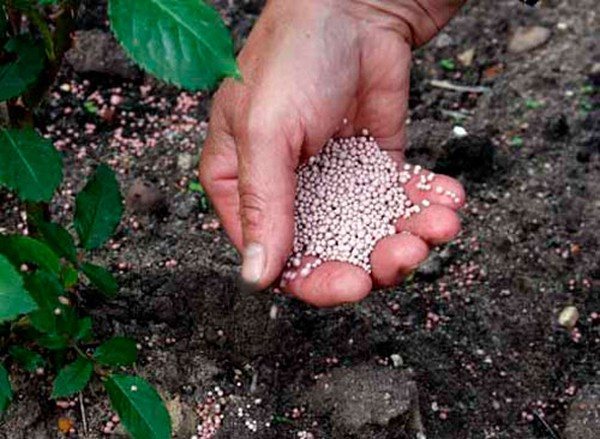

It is important to fertilize catalpa regularly
How to trim?
Cutting catalpa is useful in spring, and before the buds begin to swell. In the process, you need to delete the following branches:
- with injuries;
- dry;
- frozen out;
- sick;
- affected by parasites.
For formative pruning, a stem height of 120-200 cm is used. Above the catalpa, a low spreading crown begins. That contains four to five skeletal branches. If necessary, then the skeletal branches can be shortened, during which it is also necessary to remove the thickening stems and branches.
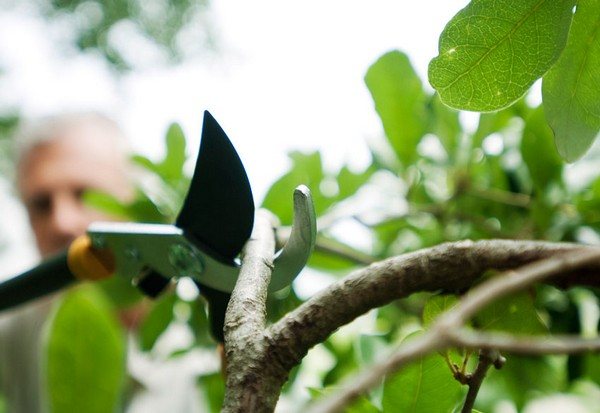

In the spring, the tree is pruned to make it easier to grow and bloom.
Planting a catalpa
You should start by choosing the right landing site. The site should have good lighting, the plant is photophilous. The second important condition is that the place should not be ventilated. Constant winds and drafts (for example, between two buildings or relief formations) will constantly oppress the tree. In addition, the leaves have a lot of wind due to their large size, and the wind damages their appearance.
The requirements for the soil are not high, from the preferences - a sufficient amount of humus, lightness, slightly acidic reaction. In addition, the soil must be well drained. The place may be humid, but not swampy.
A little about the plant
Catalpa attracts the attention of even a sophisticated gardener. Large leafy plates of bright green color create a dense crown. The inflorescences are lush, emit an amazing aroma. There are small spots on the flowers. The petals are painted in snow-white, coffee color.
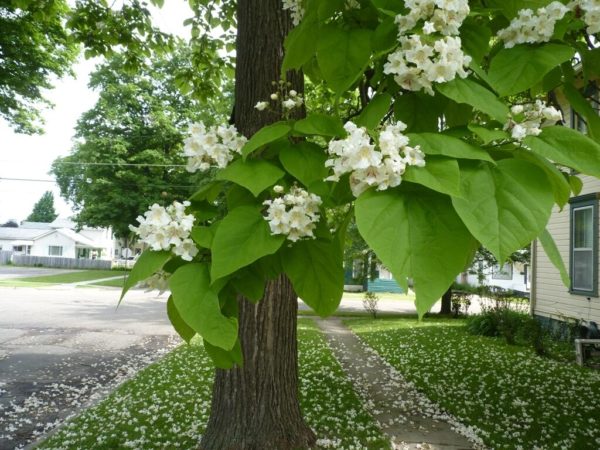

Outwardly, the inflorescences look like bells. Flowering is quite long, falls in June-July.
Note!
Catalpa will delight you with the first flowering 5 years after planting.
How to plant a catalpa correctly
It is not enough just to plant catalpa seedlings in the garden, it does not guarantee you the successful growth of the tree. Planting this culture, like any other, has its own rules. They are simple and do not require much work from you, but they must be observed if you want the tree to grow healthy and really decorate your garden over time.
The most suitable place to land
Catalpa grown in the garden for ornamental purposes should not grow too much during the growing season. Too quickly regrown branches that form the crown can freeze and die in the winter, without having time to lignify. To avoid this, choose an area with poor soil and pH7 acidity.
By the way, do you know how to determine the acidity of the soil in your area? You have probably heard this term many times, and most often we associate it with shampoos thanks to advertising. But it turns out that we have to pay attention to the level of acidity even when we work in the garden and vegetable garden. You can find out what is the pH level in the soil of your garden using a special device - an acid meter, or litmus indicator strips. Both can be purchased at specialized gardening stores. But what if there are no such shops nearby? Do not be surprised, this is possible. For example, I live in a small settlement, where no one will open retail outlets of such a narrow focus because of their unprofitability - everyone prefers to use "grandmother's" methods and improvised means. So we have our own proven methods. For example, you can put some vinegar on the ground.The appearance of small bubbles indicates that the soil is neutral or non-acidic. Grape juice can also be used by dipping a clod of earth into it. If the color of the juice changes, and bubbles appear on the surface, then the soil is neutral. Even red cabbage will help you: chop the head, boil for 10 minutes in distilled water and strain the broth (the resulting purple solution has a neutral pH). Pour a spoonful of earth into a glass of broth, and after half an hour look at the color of the juice. If it hasn't changed, the soil is neutral.
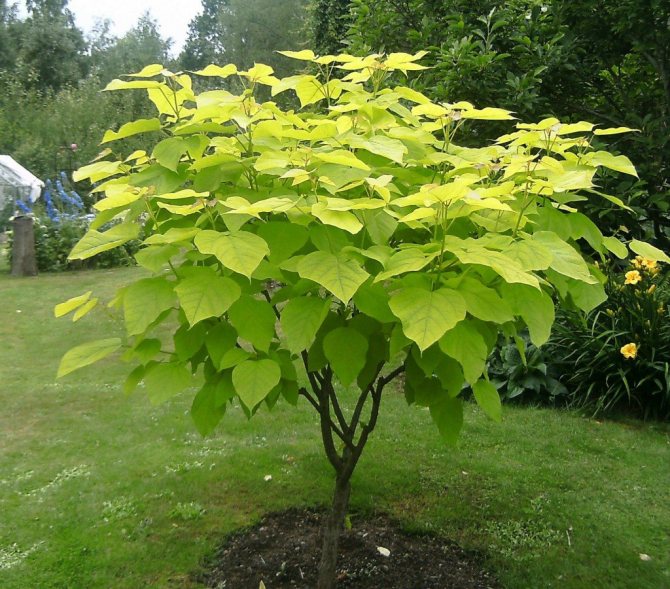

To plant a catalpa, choose a place that is well lit and closed to the winds.
In addition to a suitable level of soil acidity, the site should be open to good lighting and warmth. But keep in mind that catalpa does not tolerate drafts and cold winds, therefore, a place where a shadow often falls, completely fenced off at least on one side, is categorically not suitable. In addition, strong gusts of wind can break off thin branches and damage wide leaf plates. And the close location of groundwater will create the danger of decay of the root system or strong growth of branches, which should also be avoided.
How not to be mistaken in choosing seedlings
If you yourself grew seedlings from catalpa seeds, and at the same time did everything correctly, there will be no problems with planting material. But what if there was no such opportunity, and you want to plant an almost finished tree? Then you need to pay attention to the seedlings obtained by cuttings or layering.
It is best to apply for planting material to nurseries or to people who have been professionally engaged in growing catalpa for a long time. Their seedlings are more adapted to the conditions of your particular region, since they are grown there. That is, the first thing you should pay attention to is the winter hardiness of the culture, because in our latitudes the problem for catalpa is not only severe winters, but also short, and not always hot summers. A young seedling of a variety that is not adapted to our climatic conditions may simply not survive adaptation and die before the onset of autumn.
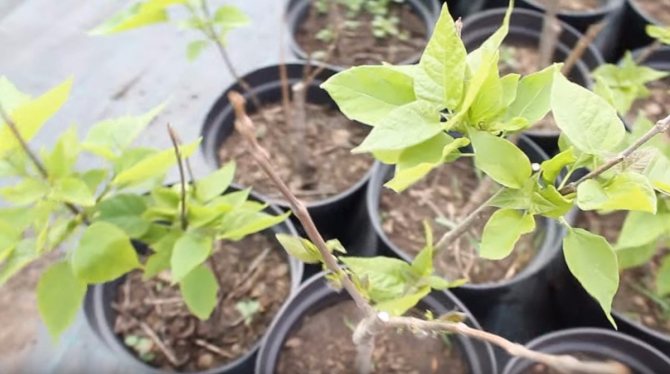

Good, healthy catalpa seedlings are best purchased in specialized nurseries.
To ensure that the plant is guaranteed to take root (naturally, subject to the rules of care at the first stages), choose seedlings 1–2 years old, 1 meter high. The root system should be wide, well developed and open.
Planting process
The best time to plant a catalpa is spring. Over the summer, the seedling will be able to get stronger, and the frosting of the shoots will not be scary to him. You can plant a tree in the fall, but in this case the risk is too great that it will not survive the winter.
Prepare the seedling hole 2 weeks before planting. Since the catalpa has wide fibrous roots, the hole should be voluminous, about 70 cm in diameter and about 0.8–1.2 m deep. Please note that this plant needs space. Keep the catalpa 4–5 meters away from other trees and shrubs.
To plant a catalpa, you need to prepare soil from the following components:
- 2 pieces of sand;
- 3 parts of humus;
- 1 part peat;
- 2 pieces of leafy land.
To increase the nutritional value of the potting mix, add 5–8 kg of wood ash and 50 g of phosphate rock to it.
Lay the bottom of the pit with drainage material (crushed stone, broken brick). Its layer should be 15 cm. Fill the hole 3/4 full with soil mixture, lower the roots of the seedling on it. Fill the remaining space with soil, compact and spill with plenty of water.
The seedling must be placed in the hole so that the root collar is just above the soil level. The position of the tree will level out when the ground subsides after watering.
Wait until the water is completely absorbed and mulch the space around the seedling within a radius of 50 cm. Peat is best used as mulch for catalpa.
Cold-resistant varieties
The following types of catalpa are suitable for the climate of central Russia:
- ordinary;
- bignoniform;
- hybrid;
- spherical.
The beautiful catalpa is more resistant to frost than the rest. She can survive in -40 degrees of frost. There are even parks with half a century and older copies. Breeder NK Vekhov in the 1930-1950s made good progress in improving the cold resistance of catalpa.


Beautiful catalpa is resistant to frost, thanks to which it can grow freely in Russia
The beautiful catalpa blooms in the second half of June. Frost-resistant species have smaller flowers, but the inflorescences are as large as in other catalpa species. The beautiful catalpa has leaves, like other species, green, but lighter.
Important! Heat and lack of moisture are very harmful to its frost-resistant varieties. These two factors cause the leaves of the tree to wither.
In the Moscow region, bignoniform catalpa usually grows only up to four meters. However, in that climate, such small sizes are possible only when the gardener neglects the rules of pruning, sheltering and feeding.
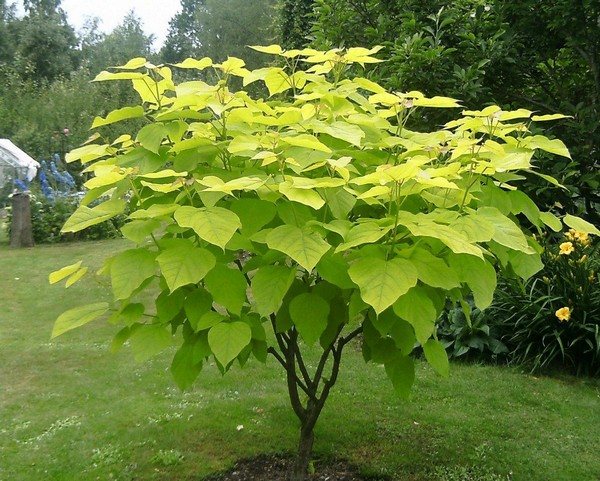

Catalpa bignoniform is usually lower than its "brothers"
Growing
One to two year old seedlings are planted in spring or autumn. Planting holes 1 m deep and 70 cm in diameter are dug in well-lit places protected from the wind.
Future trees will need free space, the optimal distance between them should be 4–5 m.
Broken brick or crushed stone must be laid at the bottom of the pit. It is recommended to enrich the land with humus, add peat, sand, phosphate rock. When planting, it is important to leave the root collar just above the soil. The soil must be tamped, watered abundantly, the trunk must be mulched.
Catalpa can be propagated by seeds, but they rarely ripen in culture. In case of success, sowing is carried out before winter or in spring in open ground.
The best results are obtained by growing seedlings. The seeds are soaked for several hours in warm water, buried in cups. The containers are kept in good lighting, temperature + 20-22 ° C. The plantings are carefully moistened and aired regularly. After the return frosts leave, they are transferred to the garden.
You can increase the number of plants with green and lignified cuttings. The use of root growth stimulants greatly increases the chances of success.
Applications and recipes
Catalpa is one of the most popular plants in oriental medicine and is used as the main ingredient in homeopathic medicines. At home, treating with catalpa is no less effective, and how to use it - read below.
Catalpa from worms
An alcoholic tincture or an aqueous infusion of catalpa leaves is used as an antihelminthic agent. Dry raw materials are taken in a 1: 1 ratio with alcohol, and fresh leaves need 3/4 for 1/4 alcohol. A bottle is filled with raw materials, poured with alcohol and allowed to stand for 2 weeks, shaking occasionally (2-3 times a week).
The finished tincture is drunk for 2-3 days, 5 ml 2 times a day. After 10 days, you need to repeat the same course. During the period of treatment with catalpa, other drugs should not be used.
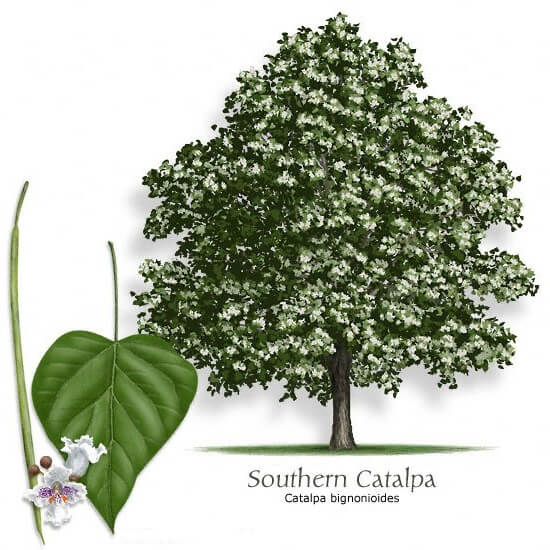

Catalpa for diarrhea
A decoction from the bark of the plant helps with diarrhea. You need to grind the bark, pour boiling water and then boil for 30 minutes over low heat. A tablespoon for 0.5 liters of water, boil down to 300 ml, and then take a tablespoon 3-4 times a day, before meals. It is important to combine diarrhea treatment with a gentle diet.
Catalpa for skin treatment
Dry leaves and flowers of catalpa are combined in equal parts, boiled with boiling water - for 1 liter, 2 tablespoons of raw materials. The liquid should be infused for at least 2 hours, then strain and use for washing the skin, compresses, wiping.
A decoction from plant seeds is no less effective for the skin. It is necessary to clean them of pods, pour cold water overnight, and boil for 10-15 minutes in the morning.After the broth has cooled, it is stored in the refrigerator, and before use, it is allowed to warm up in the room to room temperature. They are used according to the same principle - wiping, washing, compresses.
Cough catalpa
Dry cough attacks are treated with catalpa flowers, but only if it is not triggered by an allergic reaction. The color of catalpa, fresh or dry, is brewed at the rate of 1 teaspoon per glass of boiling water, the infusion is divided into 3 doses. Honey, cocoa butter are added to the drug, they are drunk warm.
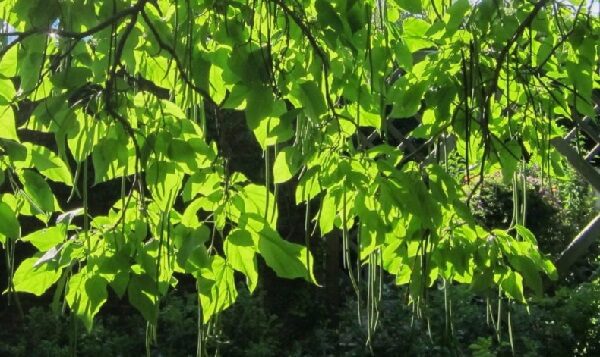

Treatment of the digestive system with catalpa
For the entire digestive system, the use of preparations made from catalpa is useful. Let's consider the features of the application.
- Alcohol tincture helps with gastritis with low acidity, enzyme deficiency. Drink a teaspoon before meals, up to 10 days. Repeat every six months.
- Liver cleansing and restoration - infusion of flowers, 20 ml, 5 times a day. Duration no longer than 2 weeks.
- With flatulence, enzyme deficiency, a decoction of the bark - a tablespoon of 400 ml, boil for 20 minutes. Drink 50 ml 2-3 times a day.
Diuretic catalpa tea
Substances that stimulate the elimination of excess fluid from the body are predominantly found in the leaves of the tree. It is easy to make tea from them - pour 1 teaspoon of raw materials into the teapot, brew and strain 50 ml each before use, dilute with boiling water and drink. Take 3-4 times a day.
Catalpa for diabetes
For diabetes, use catalpa tea, a decoction of seeds and bark. They drink after meals, about 30-40 minutes later. Helps restore blood sugar levels, eliminate unpleasant symptoms.
- Decoction recipe - 500 ml of water, 2 tablespoons of raw materials (a mixture of crushed bark and seeds).
- Boil for 5-7 minutes.
- The dosage is 20 ml per dose.
- You can be treated for no longer than 3 weeks.
Testimonials
Catalpa today has ceased to be an exotic rarity in our latitudes - it is grown in gardens, in summer cottages, in city parks. This plant has adapted well to climatic conditions and is becoming more common.
In addition, more and more people are using catalpa for treatment. Consider reviews of catalpa treatment.


Did you like the article? Share it with your friends on social networks! Do not miss the latest publications - subscribe to the site news and read them first!
We wish you health and success!
How to reproduce?
Here you can use either of these two methods:
- generative - by seeds;
- vegetative - cuttings.
Catalpa seeds do not need to be stratified.
Seed propagation
Catalpa seeds are planted in pre-dug grooves. Then they are sprinkled with soil and create a greenhouse effect so that they can germinate. A box covered with glass can help here. This very glass must be lifted from time to time in order to ventilate young plants.
The temperature around the seedlings should be twenty degrees Celsius, plus or minus five degrees. They also need to be watered moderately and provide them with diffused light from the sun.
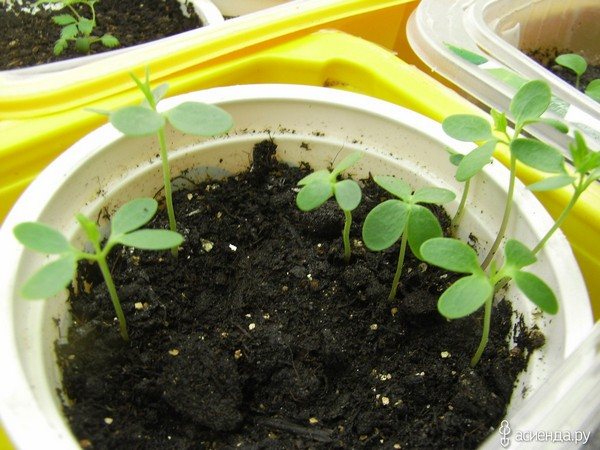

Catalpa can be propagated by seed, but it is not easy
Important! In the spring, when the seedlings grow up, it's time to plant them in open soil. But not earlier than the stable warm air temperature is established. This usually occurs in the second half of May.
Propagation by seedlings
For planting seedlings, a pit of about a meter deep and seventy centimeters wide is required. More precise dimensions are determined by the dimensions of the seedling. Having dug a hole and poured a drainage layer, its bottom should be covered with a mixture of sand, peat, five to seven kg of wood ash, as well as fifty grams of phosphate rock.
Themselves such pits should be separated by a distance of three to five meters. A more accurate distance is determined by the type of catalpa.
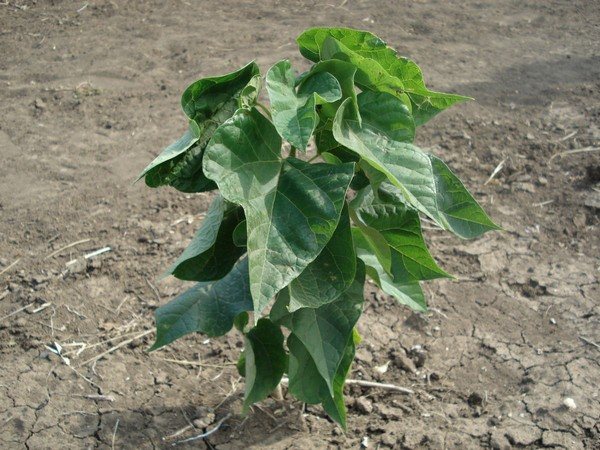

Seedlings should be placed in a pre-dug hole about a meter deep
Further, the seedling must be maintained in an upright position, while sprinkling it tightly with soil and watering abundantly. It is necessary that the root collar, as a result of manipulations, be flush with the ground surface.
Important! Immediately after the catalpa is planted, it is best to mulch the trunk circle.
Further, young seedlings must be watered every week. And for the winter they need to be covered in the first years of growth. Otherwise, the plants may die from the cold.
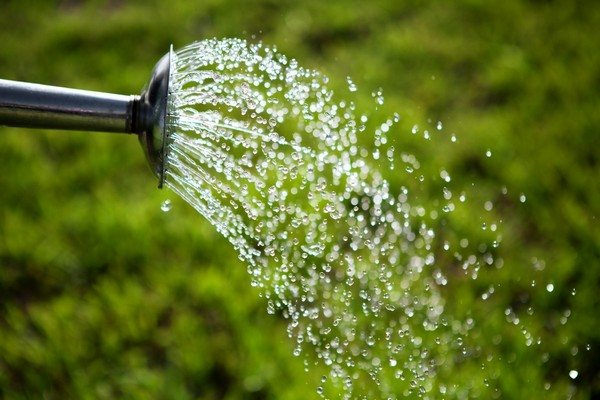

Young trees need to be watered weekly.
In case of failure to grow seedlings on your own from seeds or cuttings, it is better to contact a special garden store. It is recommended to buy annual seedlings that are grown up and stronger. It is also important to purchase seedlings in the stores of the region where they will then grow: these are the ones that are most adapted to the corresponding climate.
Important! Young catalpa gains in growth of about a meter per year. The first flowering begins only in the fourth or fifth year.


Catalpa grows by about a meter in a year.
Propagation by cuttings
Cuttings must be harvested on mature trees. This should be done in the summer, but not earlier than the middle of the warm season. The stalk is required to be approximately eight centimeters long and contain several buds. The cuttings are rooted in a mixture of peat and sand. Having planted them in it, you need to cover the container with a transparent cap. Further caring for cuttings is similar to caring for seedlings obtained from seeds. Rooting of cuttings can be seen by the appearance of young leaves. Rooted cuttings are transplanted into open ground after mid-May.
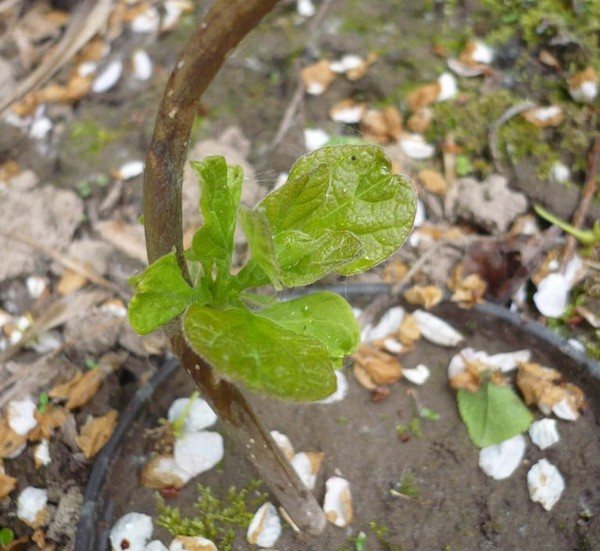

Cuttings need to be prepared in the summer
Planting young seedlings
If the seedling is purchased ready-made, it is enough for it to prepare a spacious hole of at least 1 m in all dimensions, shed it abundantly, equip drainage (if the soil is dense), fill it with a small layer of soil and apply fertilizer. Wood ash in combination with superphosphate will work well. Maintaining the level of the root collar is imperative. If there are several seedlings, you need to leave at least 3 m of free space between them.
The best planting material is a one-year-old seedling, and the planting time is early spring.
Chemical composition
The composition of catalpa is not well understood. The bark contains tannins and special resins, and they give it useful qualities. In the leaves, experts found the presence of glycosides.
The seeds also contain about 30% oil rich in eleostearic acid. All these substances make the composition of the culture quite rich, and it can have a complex effect on the body when used for therapeutic purposes.
1
3
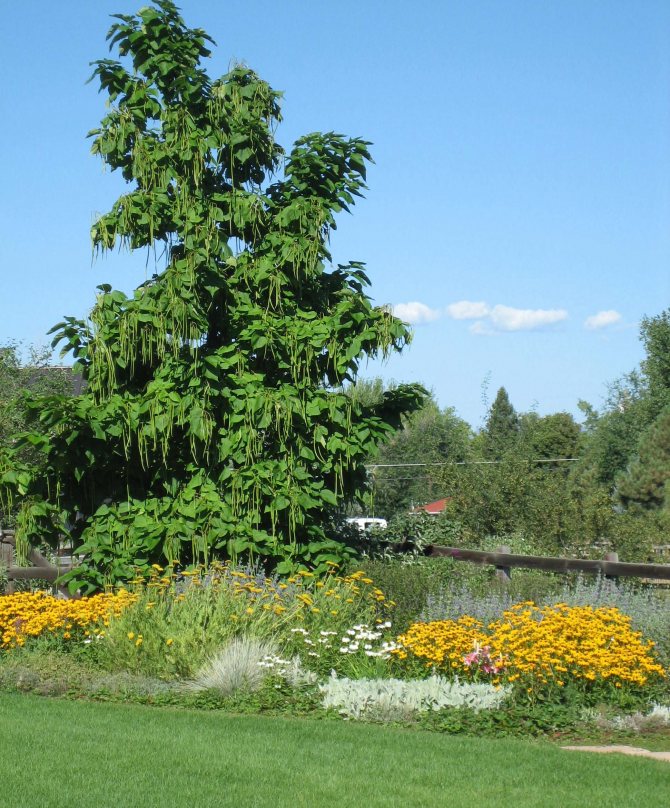

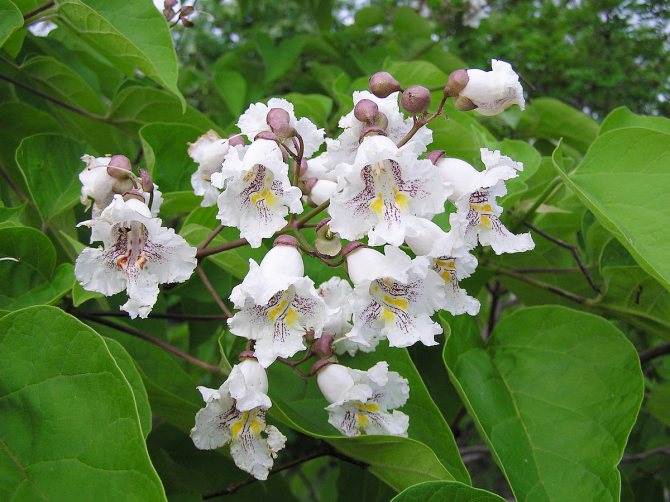

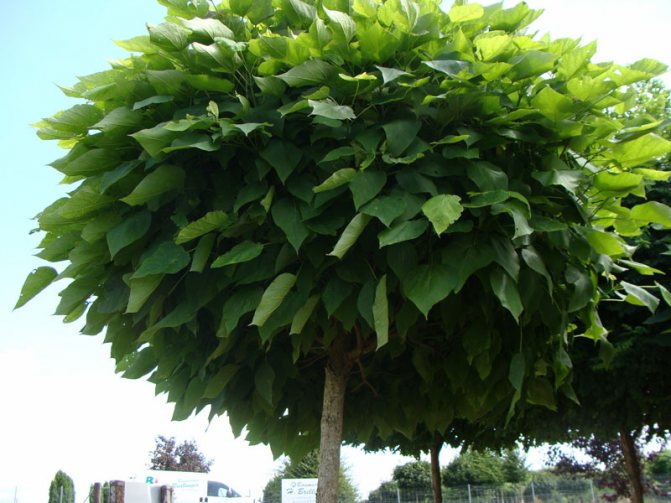

Bignonium and ovoid catalpa
Catalpa bignoniform is characterized by spreading branches forming a wide rounded crown. The height of the tree is 10-12 meters, the bark is light brown, lamellar, large, wide leaves about 20 cm in length, pubescent on top. Long bloom, about 1.5 months, occurs in July-August. Catalpa bignonium is presented in several varieties:
- Nana. It is characterized by a compact, spherical crown, reaching a diameter of 2-4 meters.
- Aurea. At the beginning of the growing season, it stands out with golden leaves.
- Kene. Leaves are characterized by a green center on a yellow background.
- Purpurea. It is characterized by reddish-brown leaves when blooming.
All varieties grow rather slowly; Nana has the highest winter hardiness.
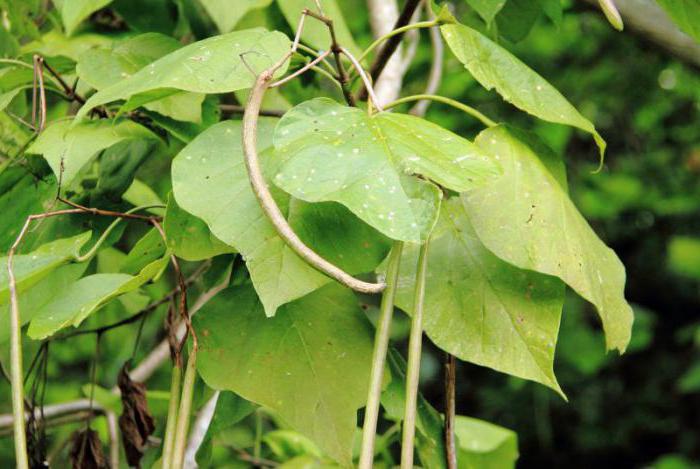

Ovate catalpa is found in multi-stem shrub forms. Unlike catalpa bignoniform and magnificent, it has a short growing season. Its shoots have time to woody before the onset of cold weather, so the plant practically does not freeze. Able to withstand 29-degree frosts.
Contraindications
Catalpa is toxic, therefore it is not used in any way to treat a sensitive category of people. It is necessary to coordinate the use of the plant for medicinal purposes, first of all, with a doctor, and it is also advisable to consult an experienced herbalist. Consider also a list of categorical and temporary contraindications.
- Pregnancy at all stages.
- Breast-feeding.
- Children up to age 14.
- Diseases and tumors of the adrenal glands.
- Heart failure.
- Increased blood clotting.
- Individual intolerance.
A side effect from the use of catalpa, even in the absence of contraindications and adherence to the dosage rules, is nausea, dizziness, drowsiness. Side effects are not always and not at all. However, it is important to know what to do in such situations. It is advisable to temporarily stop taking herbal remedies, rinse the stomach and consult a doctor if the condition worsens.
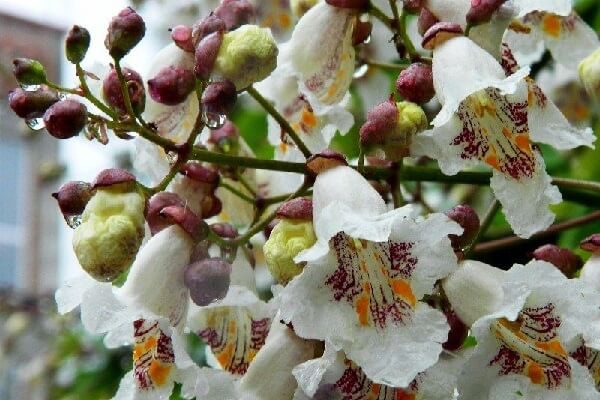

Application
Catalps are decorative and contain biologically active substances.
Wood
The wood massif resembles oak in its technical properties. The plant is often called American or French oak. The most common source of lumber is the longest catalpa... This is a fairly massive breed that grows in Haiti, Cuba, Jamaica and other parts of the Caribbean. Other species do not grow enough wood.
The core of the logs is grayish-brown, with a pronounced natural pattern. The sapwood is lighter. The fibers are straight, the structure of the material is homogeneous. Density of dried wood is 690–800 kg / m3. Catalpa is resistant to swelling, fungal attack, it lends itself well to mechanical processing... It is used in the manufacture of furniture, parquet, finishing materials. At home, timber is used for the construction of ships, the construction of frames for low-rise buildings.


Healing properties
The bark, leaves, flowers contain a complex of resins, tannins, glycosides, essential oils, tannins. Dried raw materials are used in alternative medicine to treat diseases of the digestive and respiratory systems, infectious pathologies, and inflammation of the joints. With infusions of flowers, cuts, ulcers are washed, they are applied to boils. In veterinary medicine, the leaves are added to cattle feed to prevent parasitic infections.
Landscape design
Due to their high decorative and adaptive qualities, catalps are excellent for landscaping streets, creating hedges, garden ensembles. Large dense foliage gives off a lot of oxygen, retains dust... Flowering trees are very picturesque, look good in group and single plantings, they can decorate any landscape. Catalps go well with coniferous shrubs, jasmine, hawthorn, holly.


